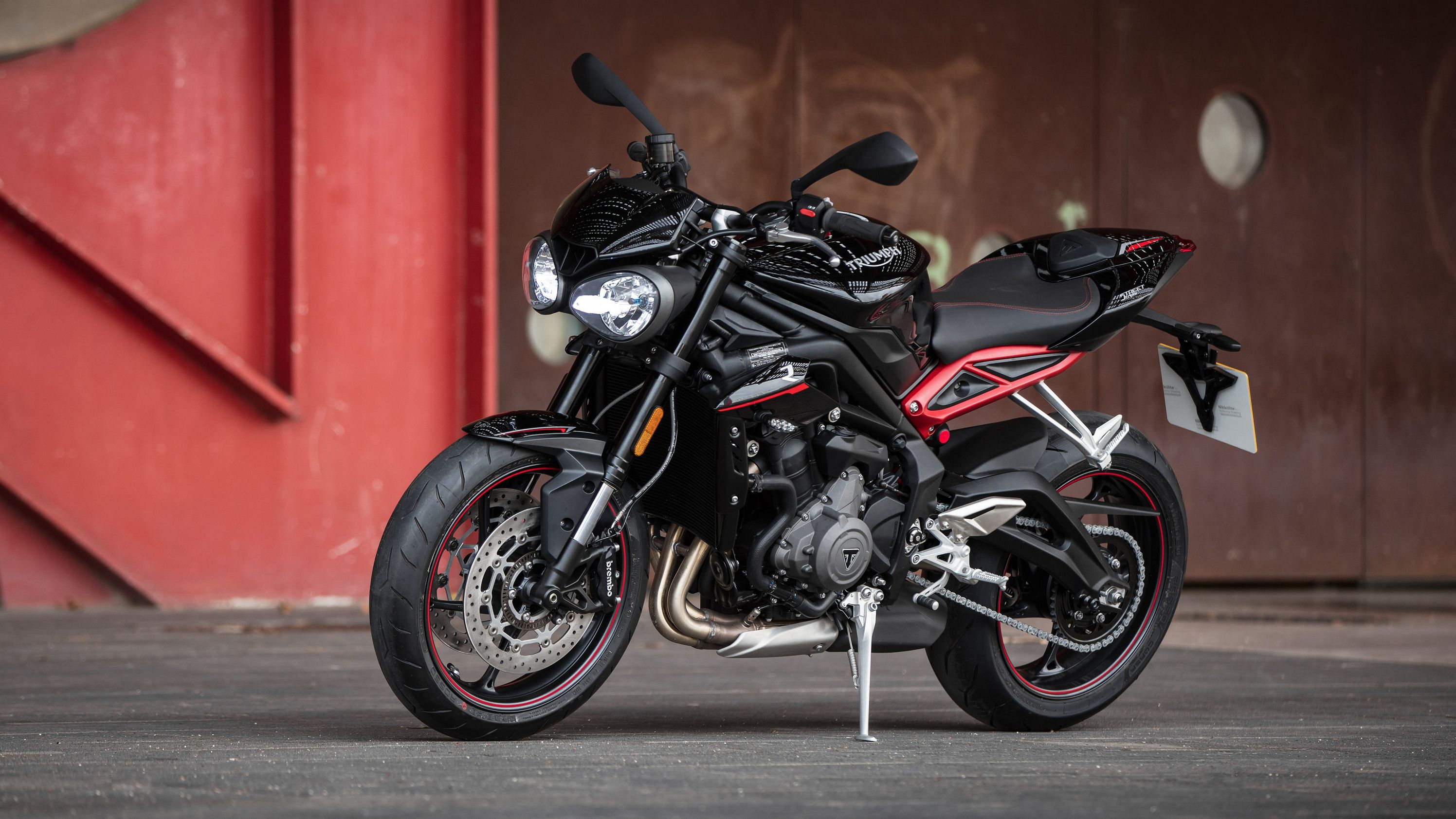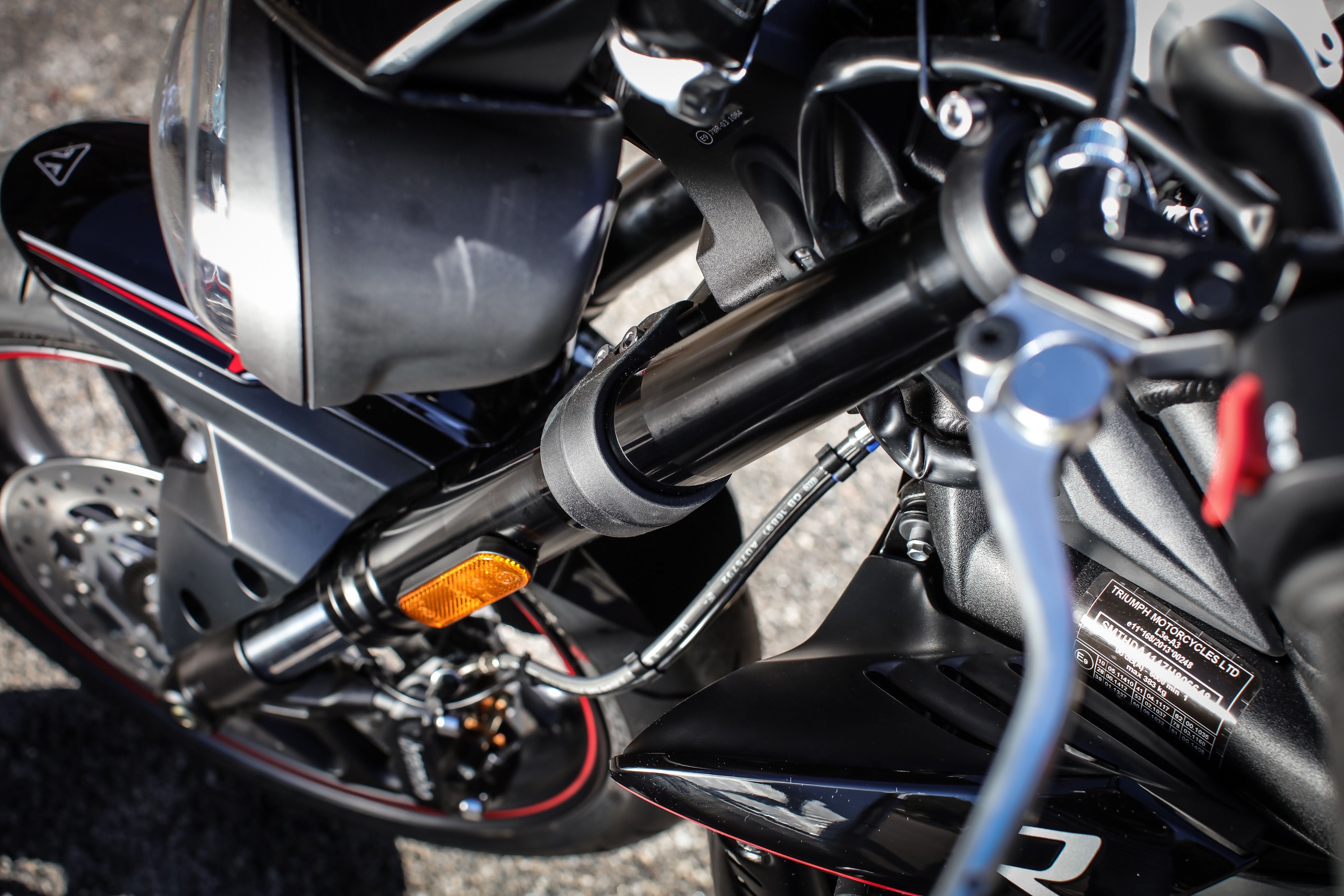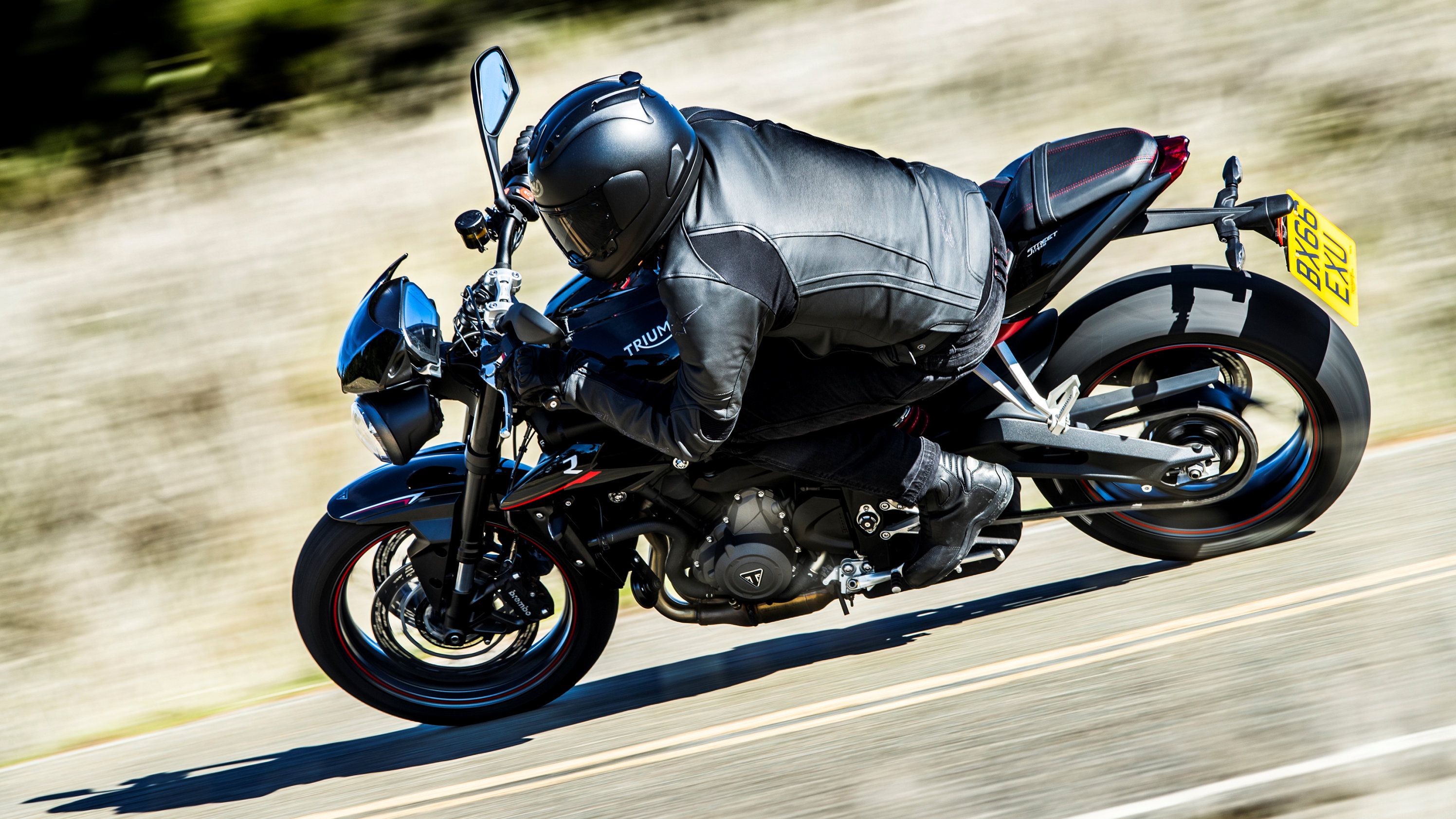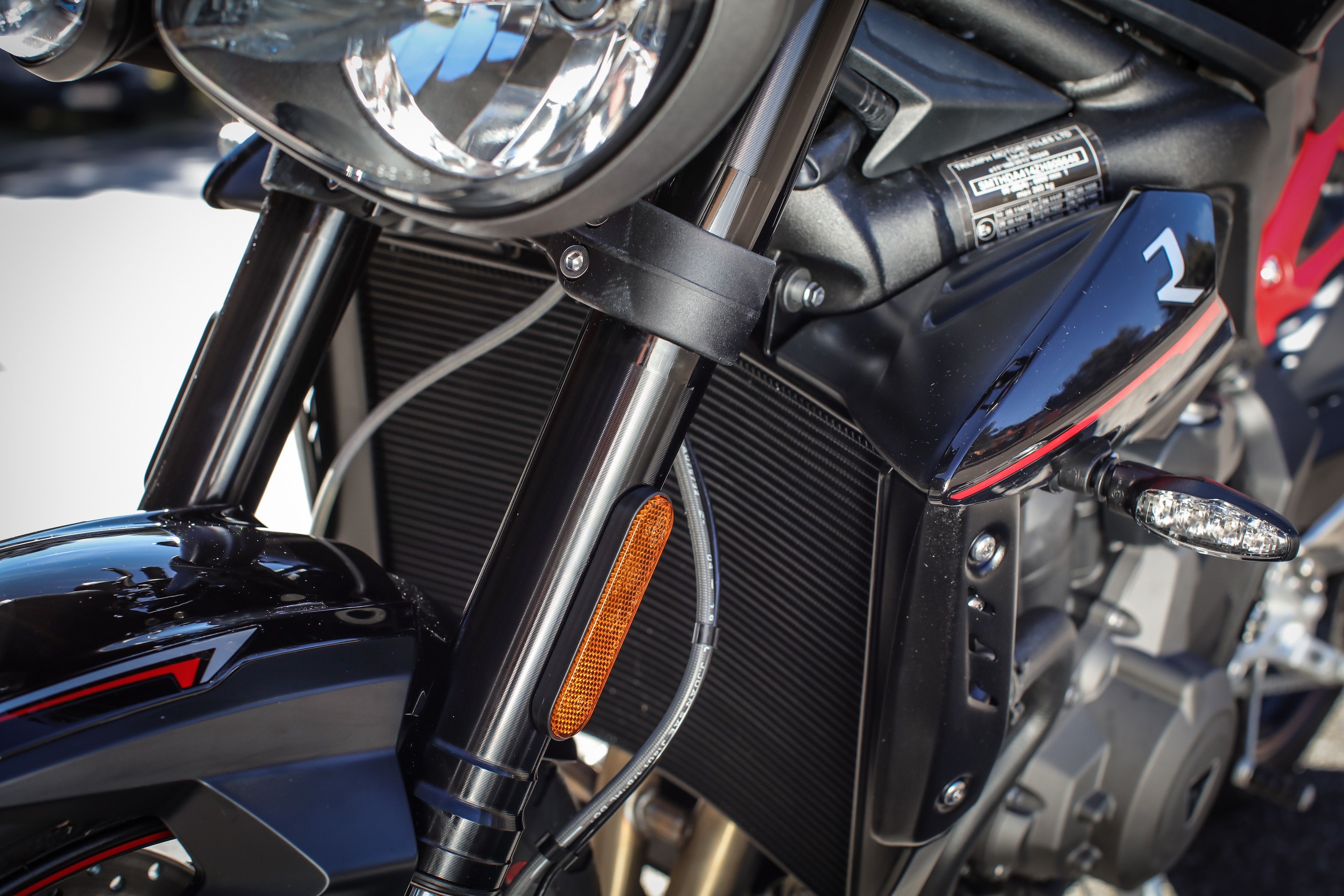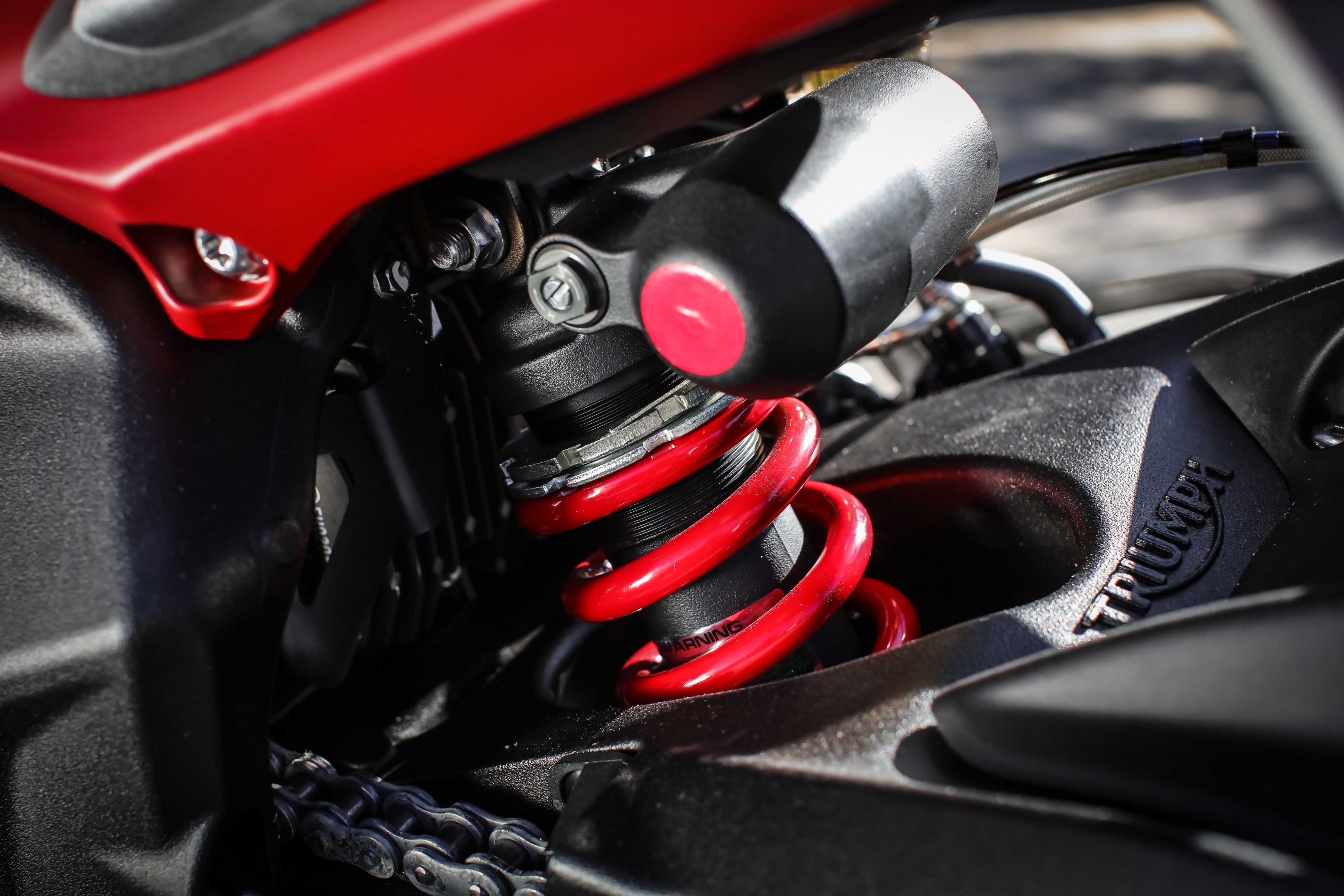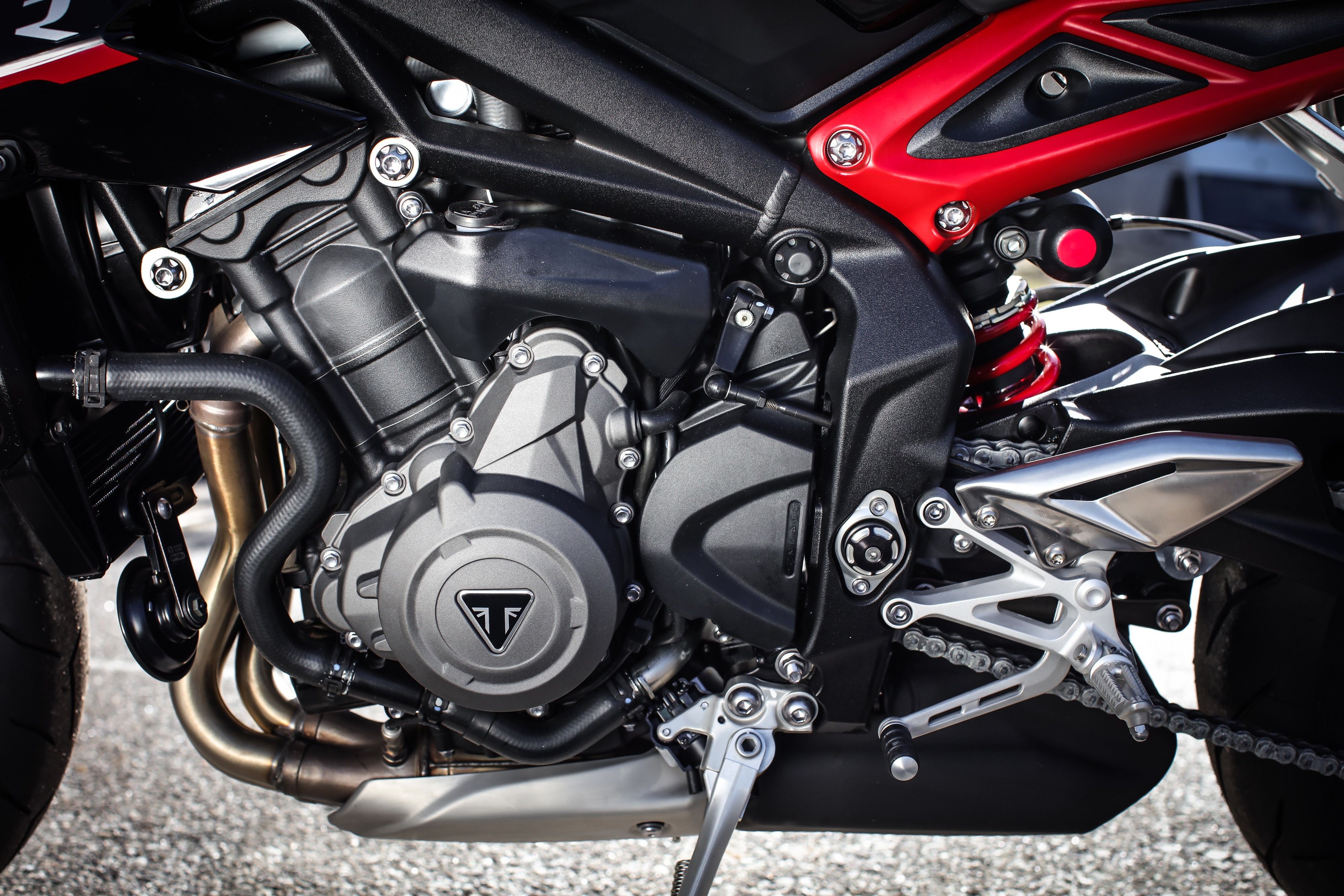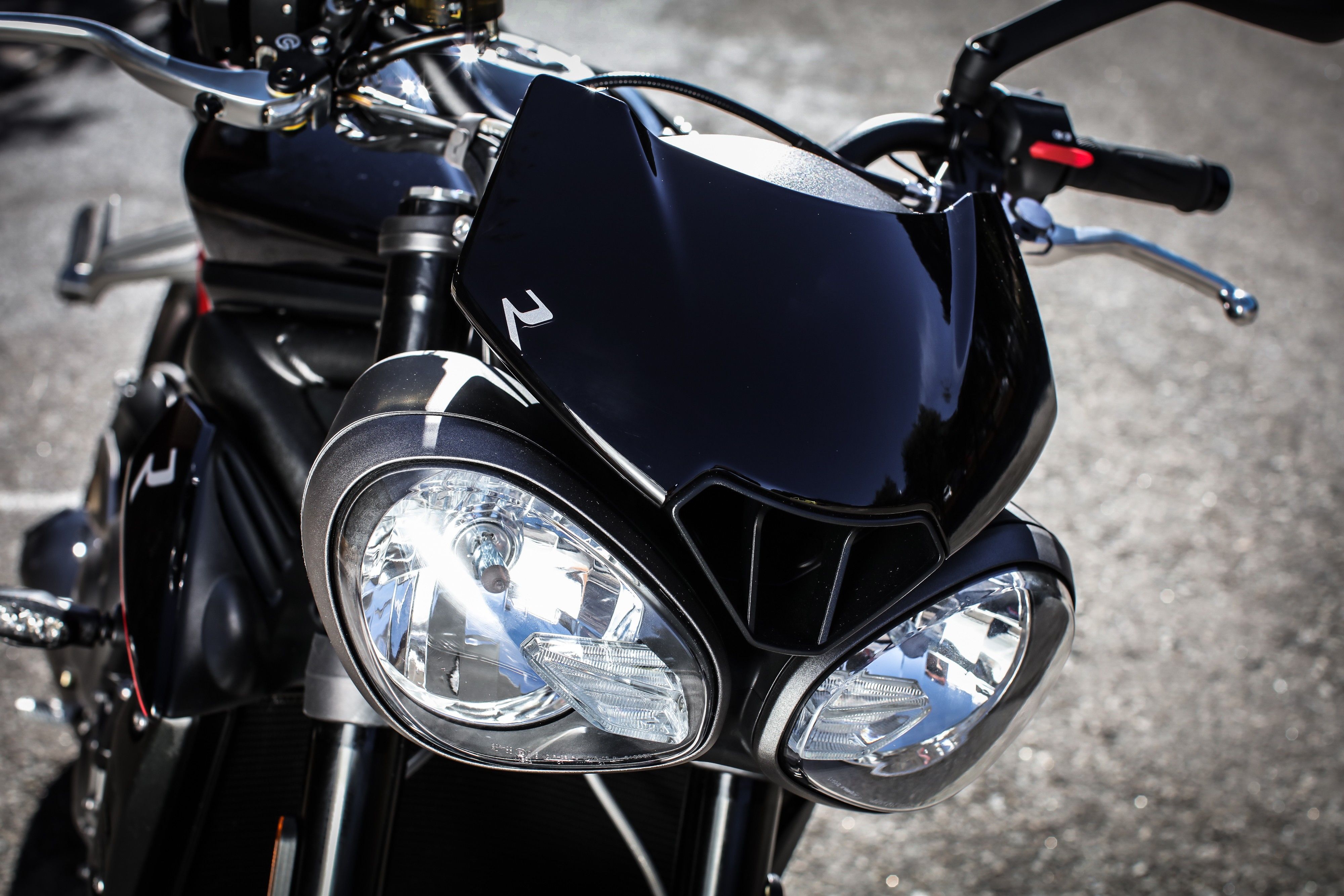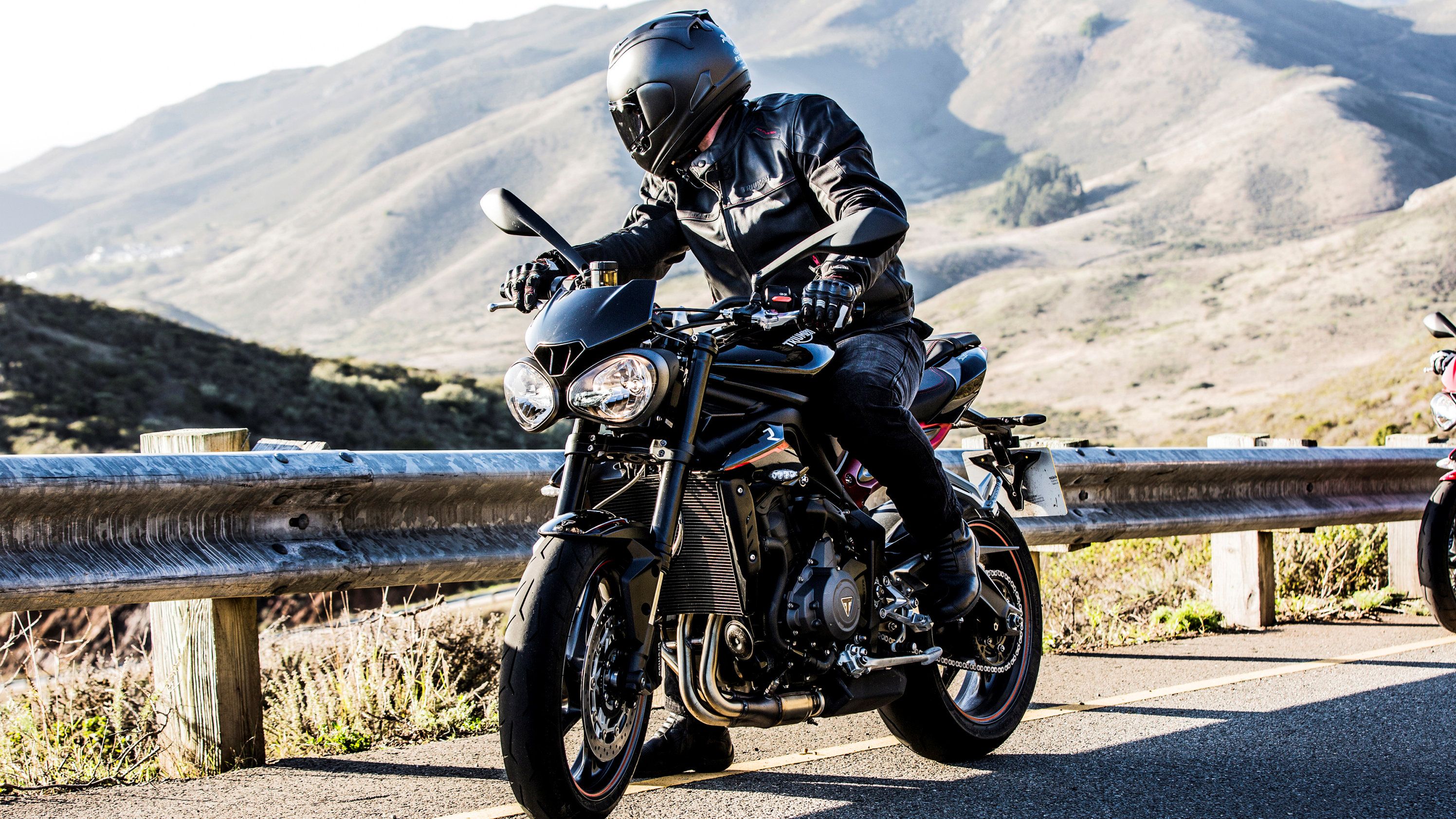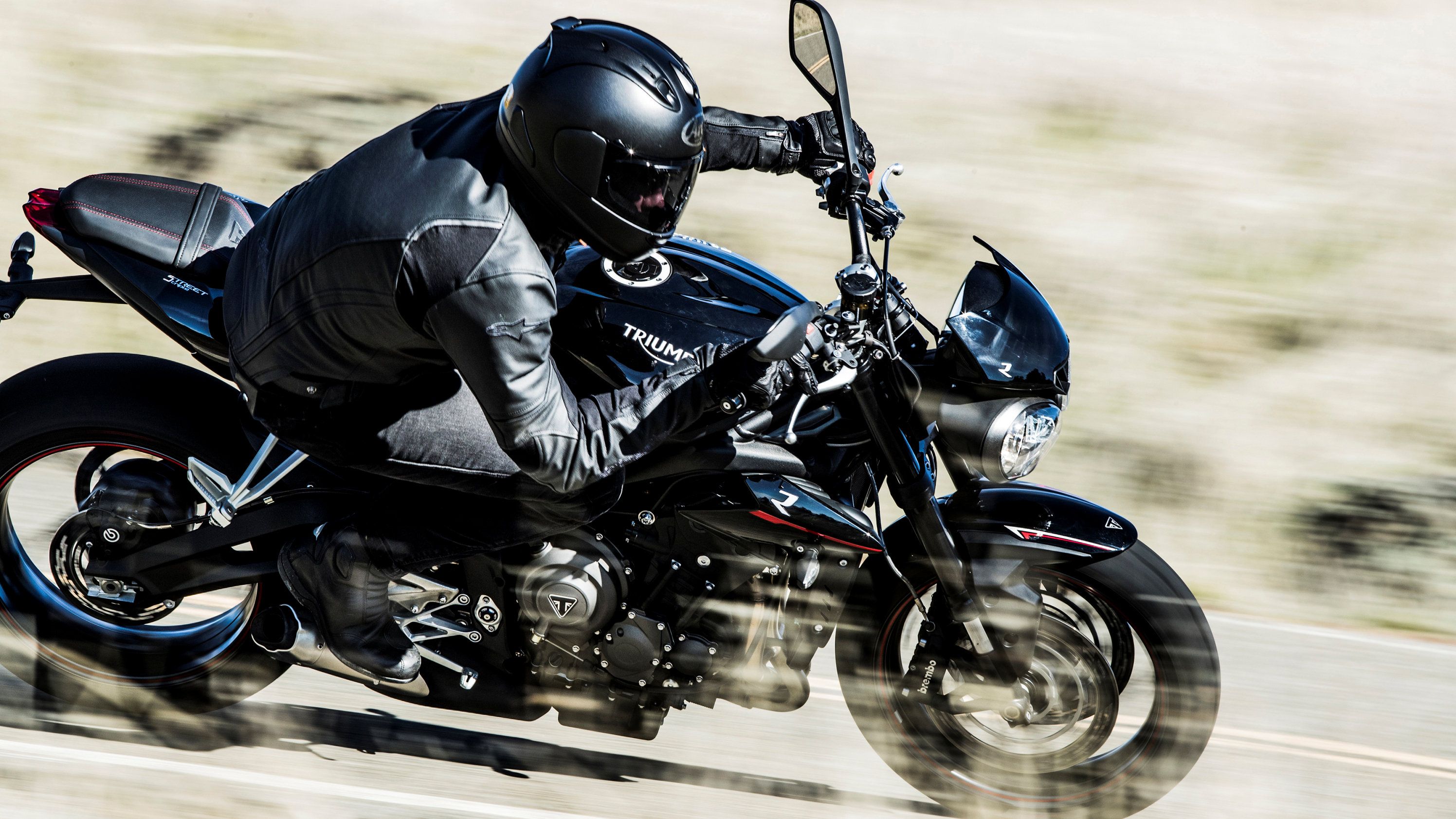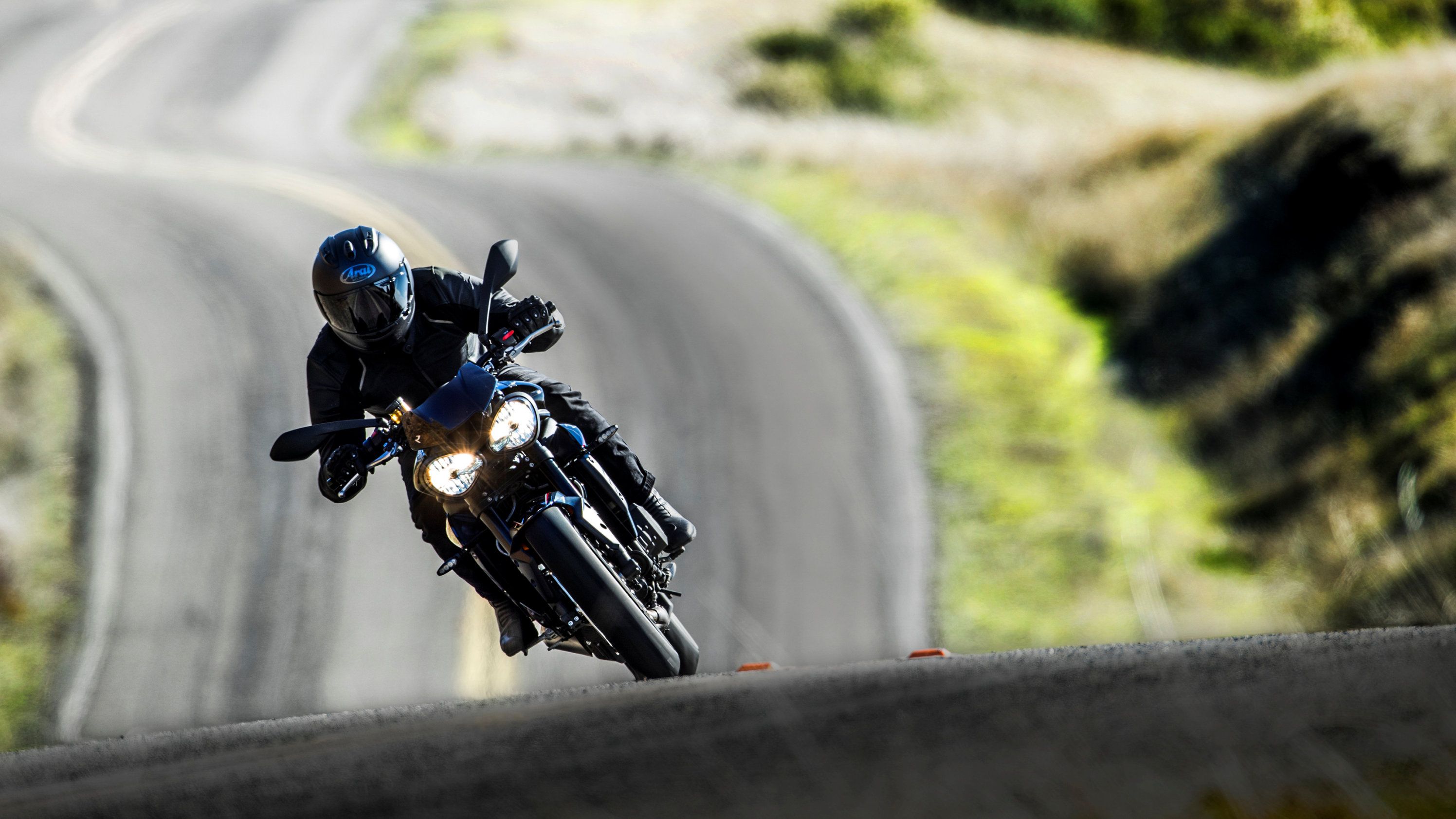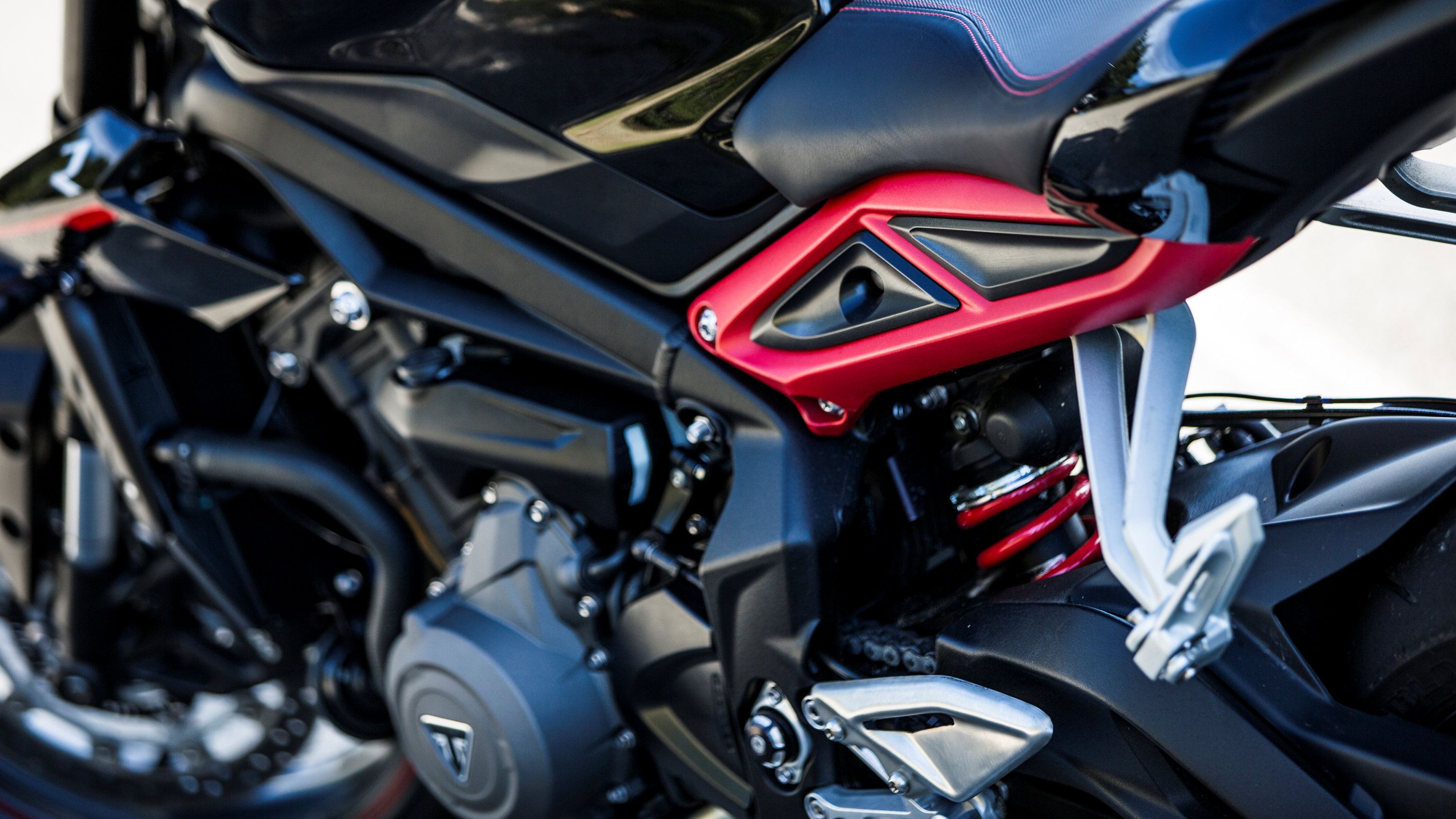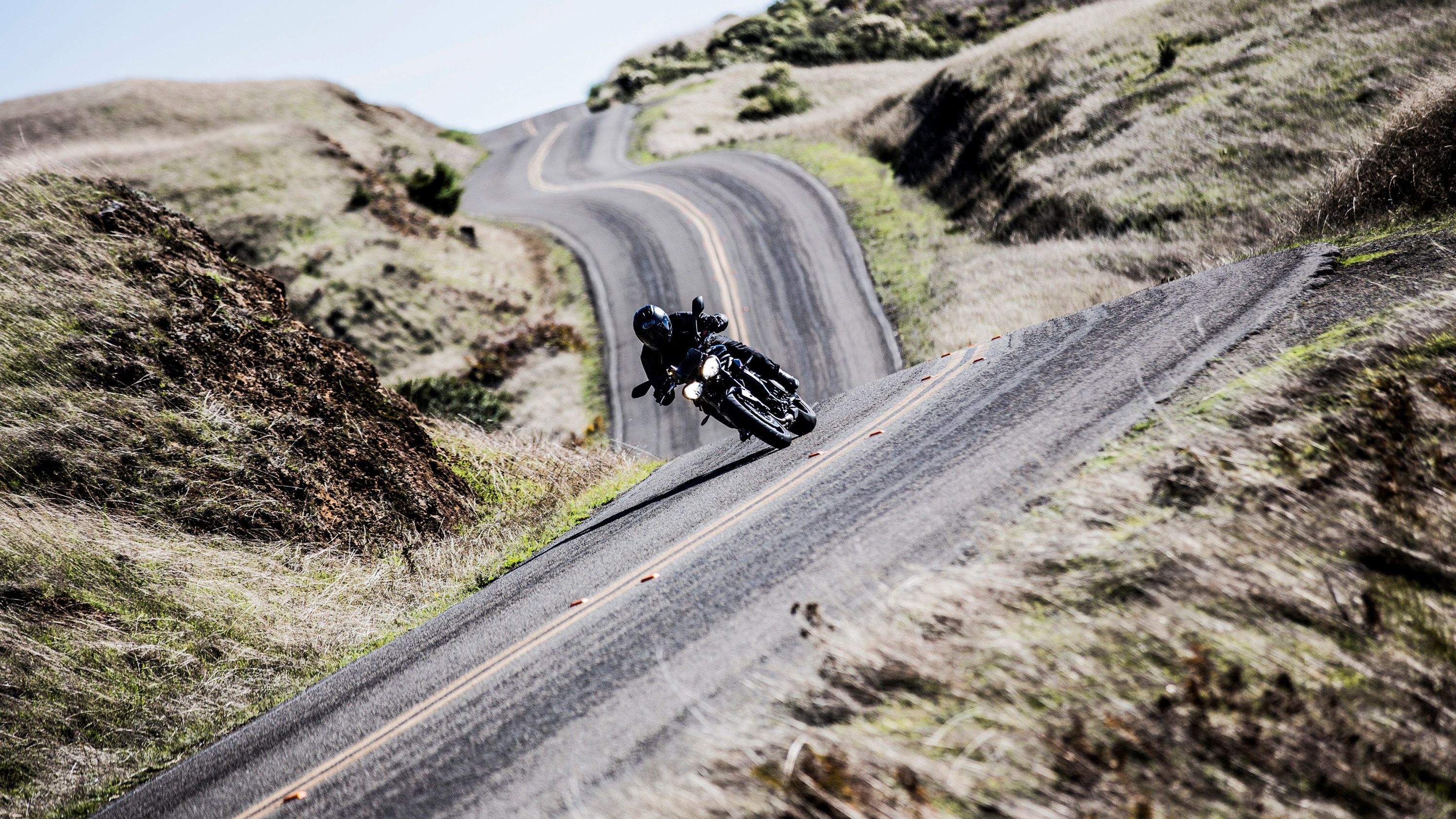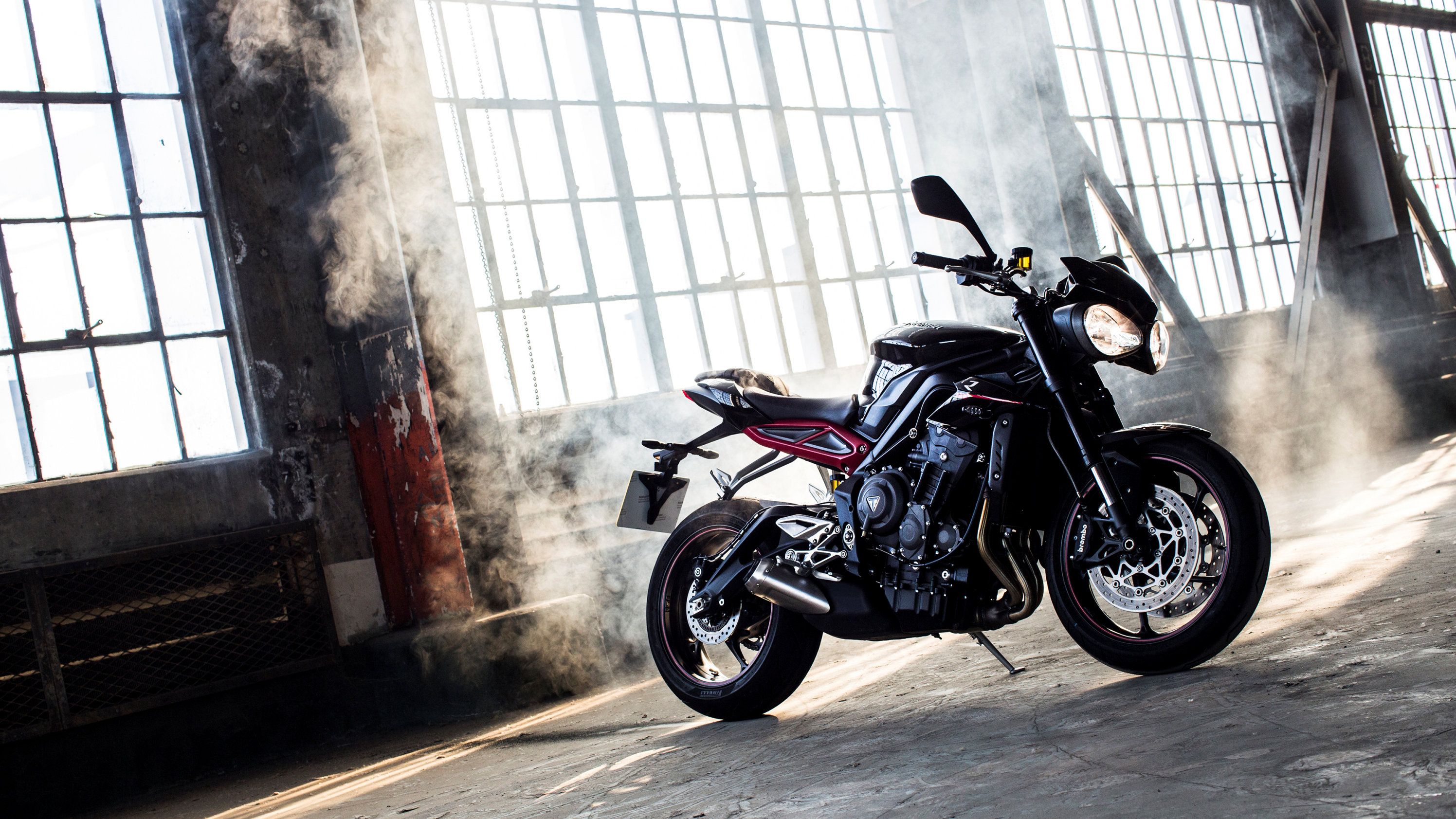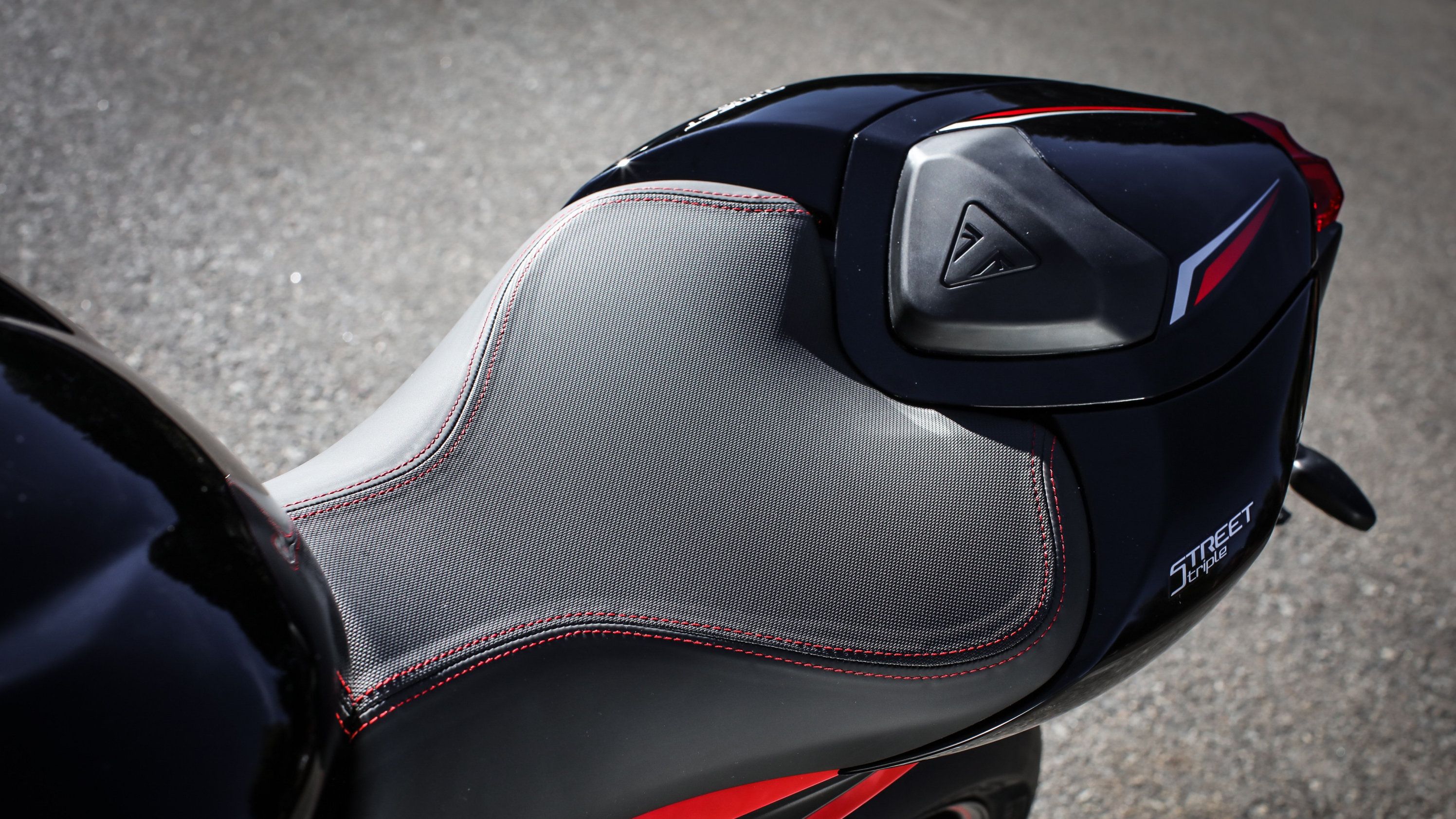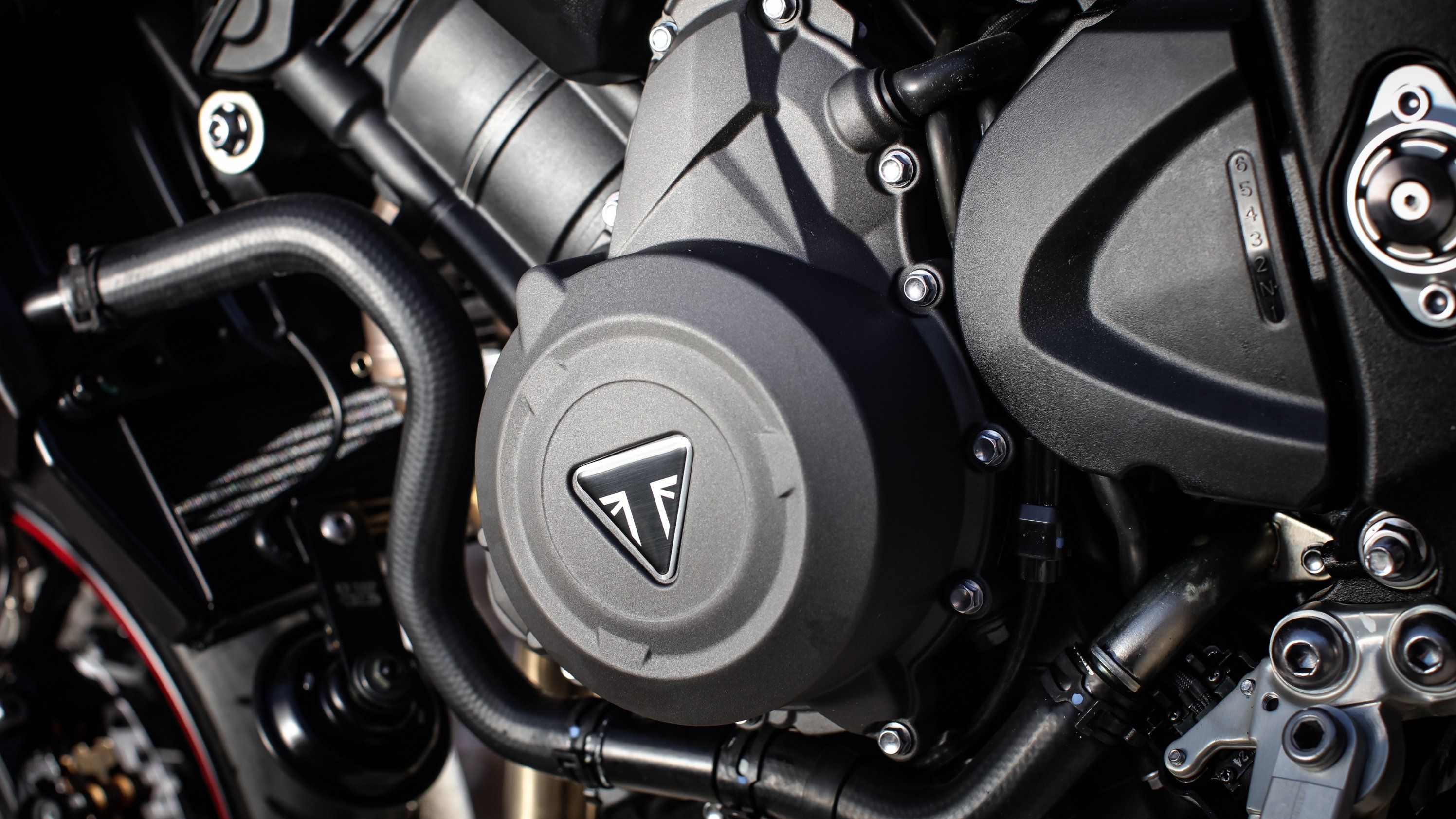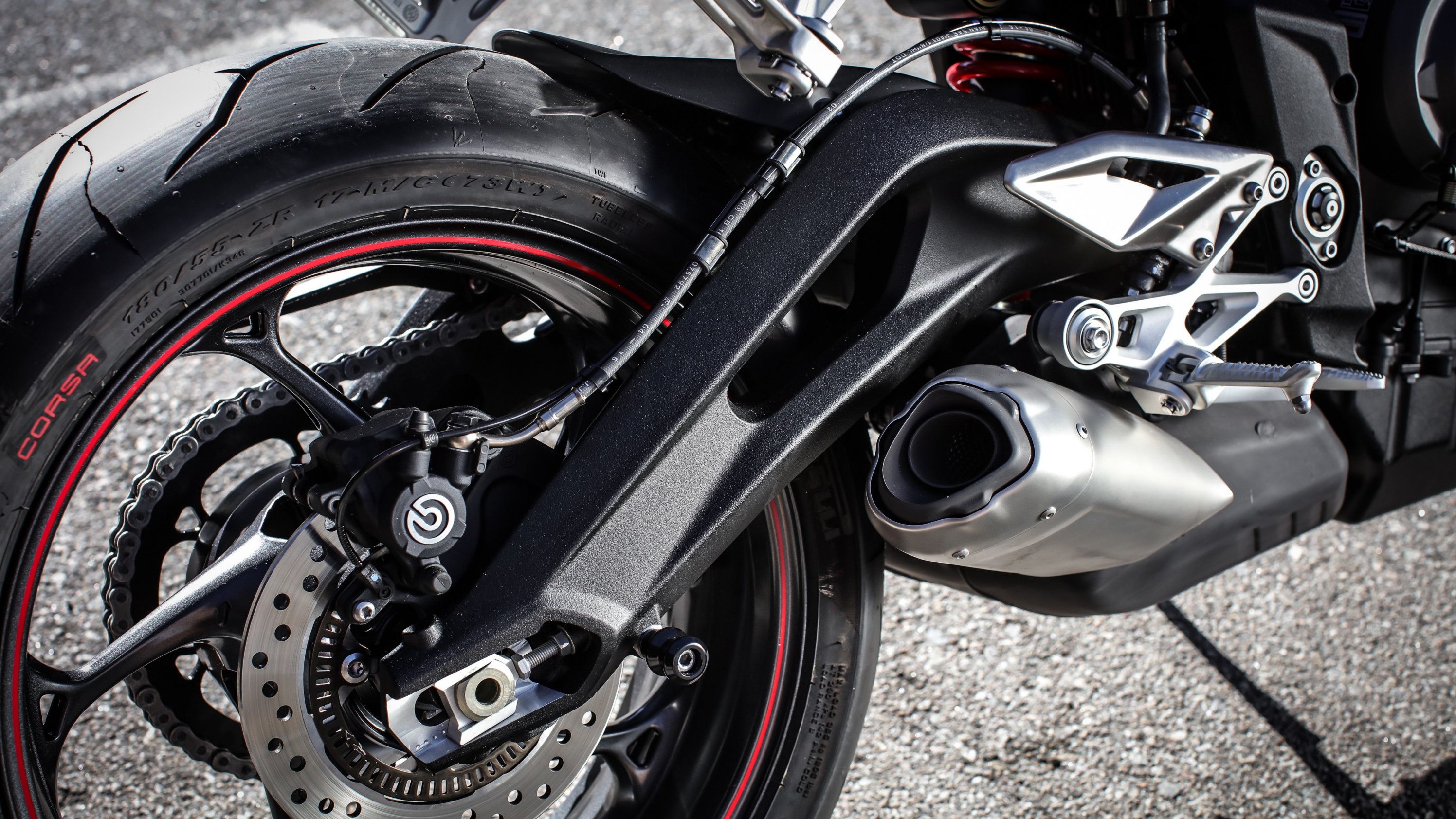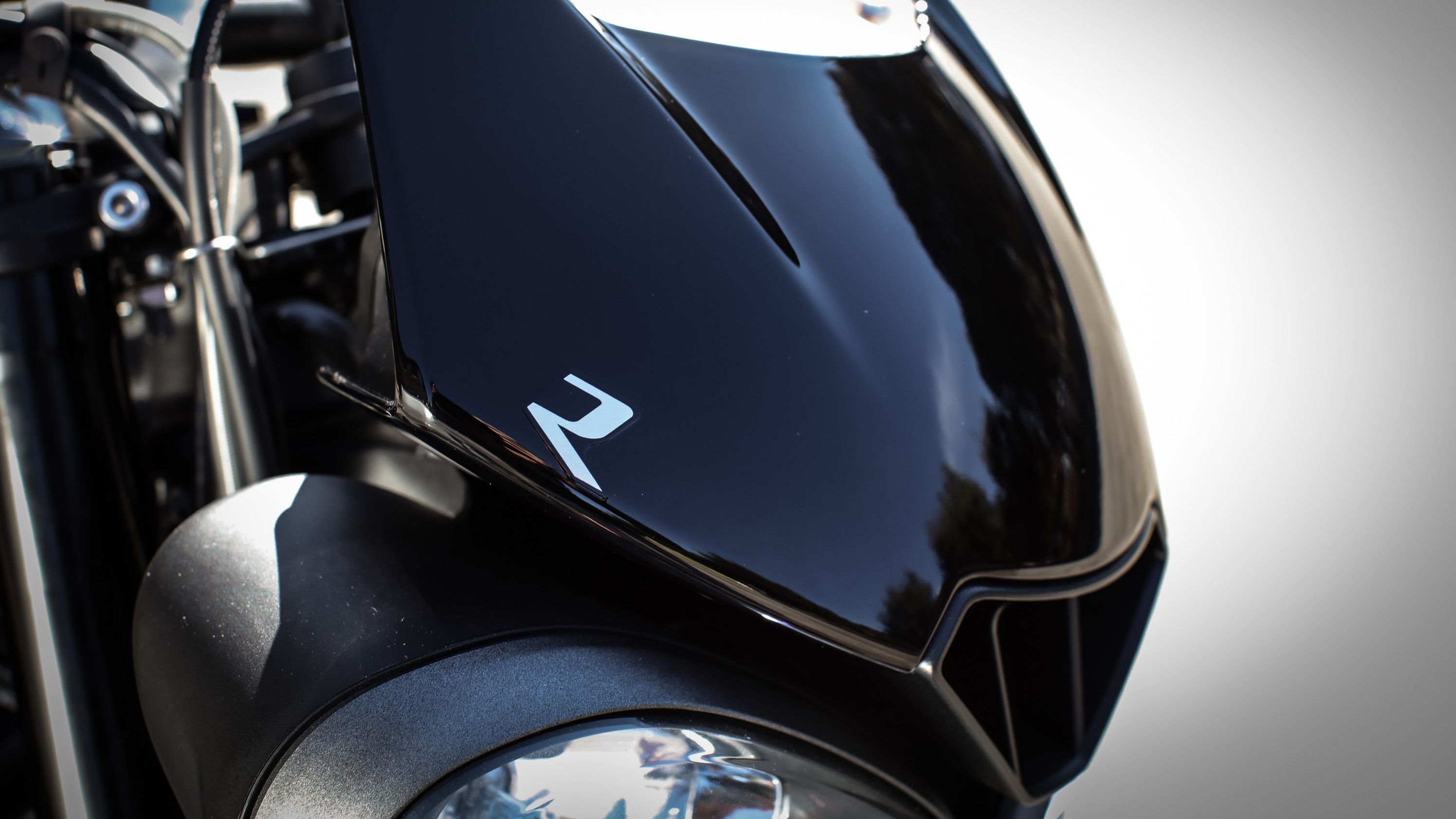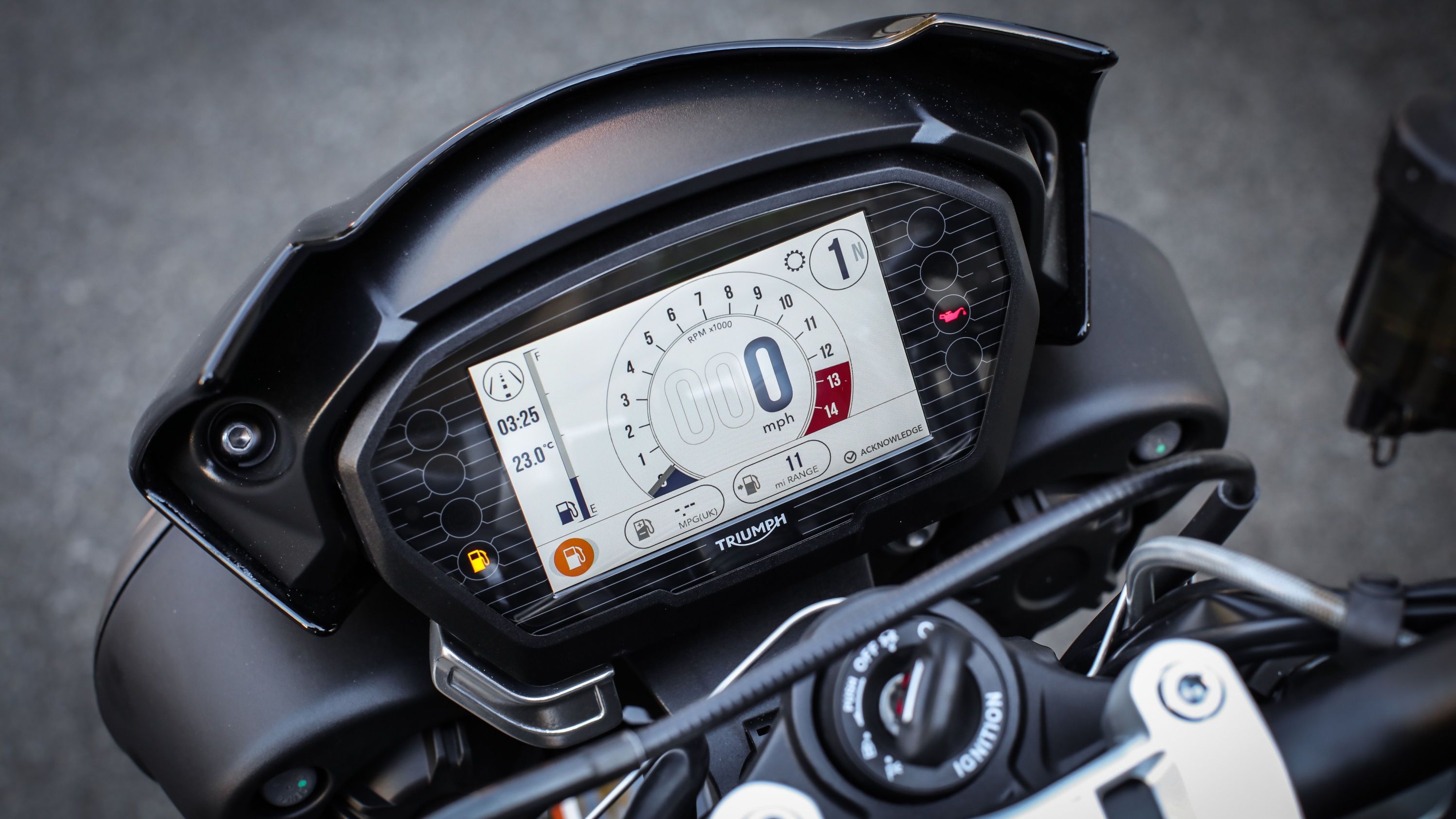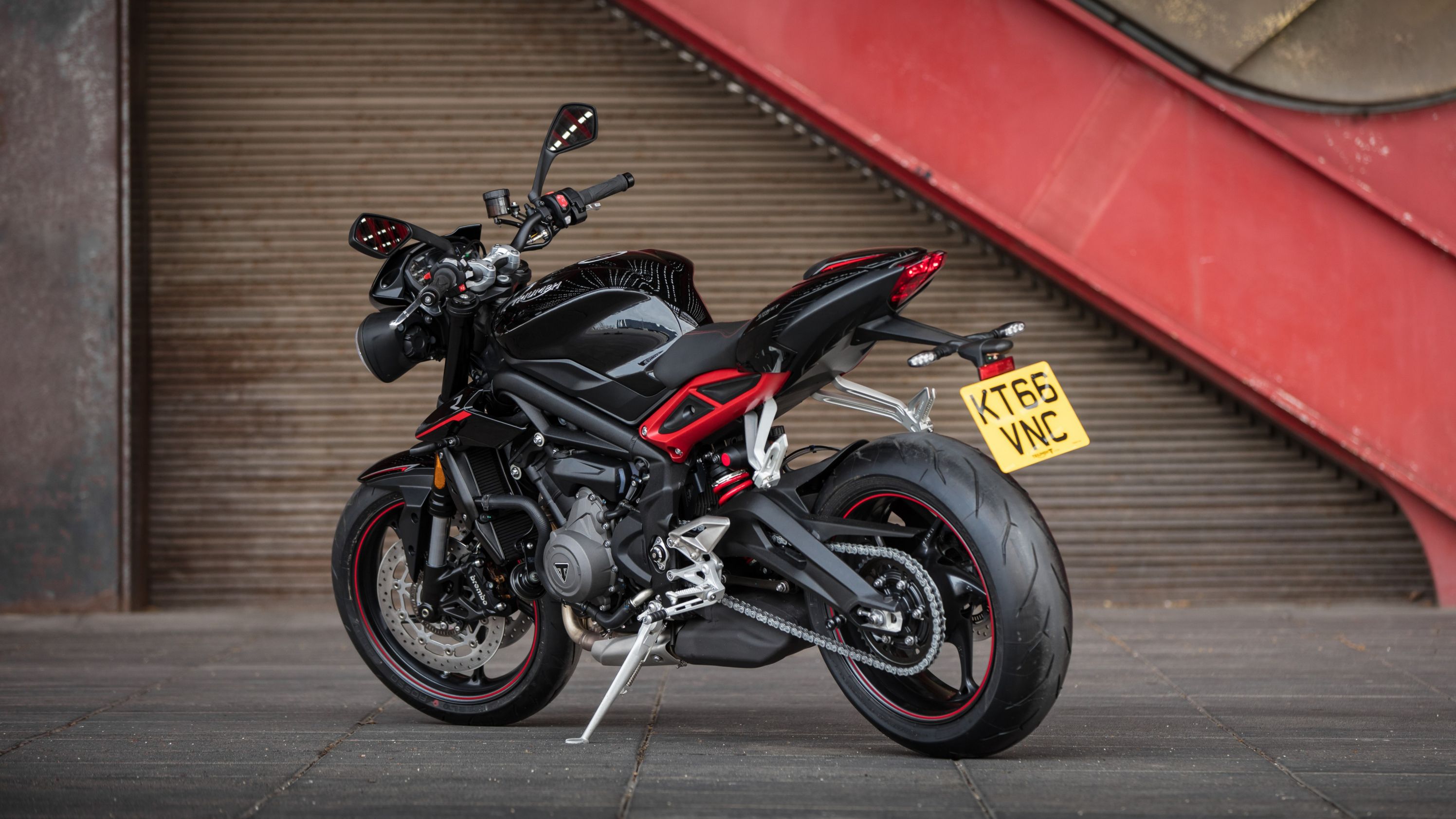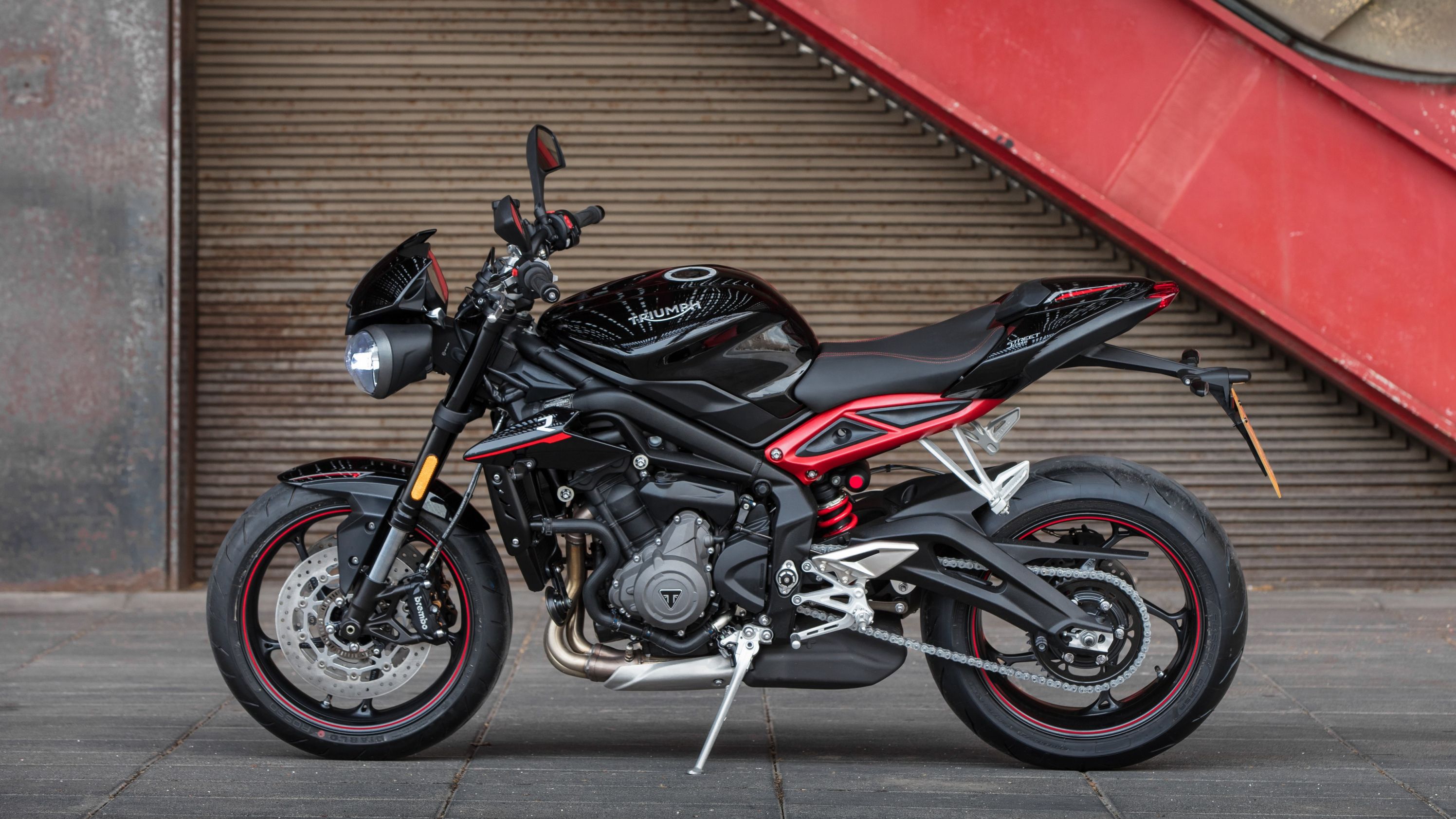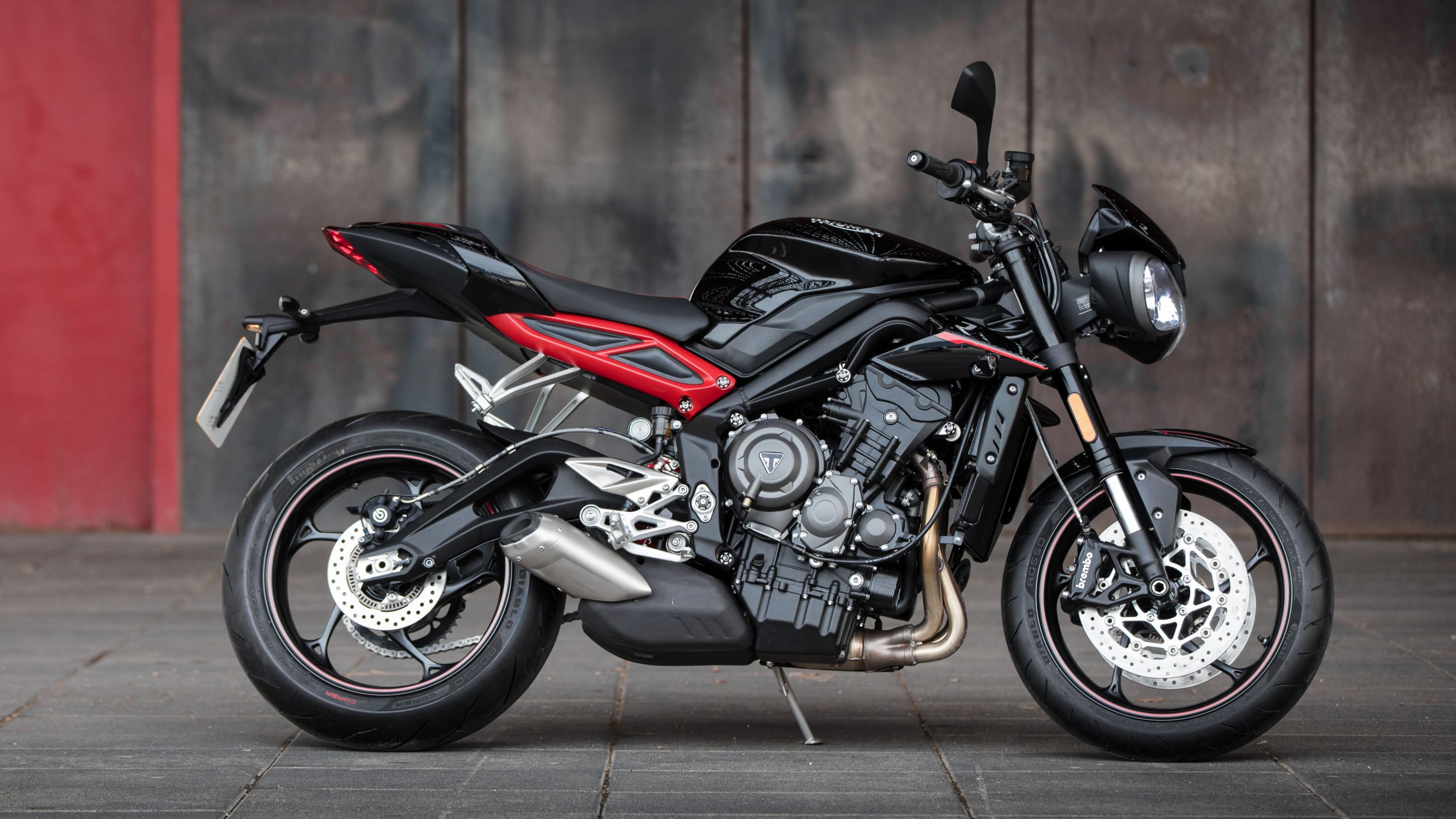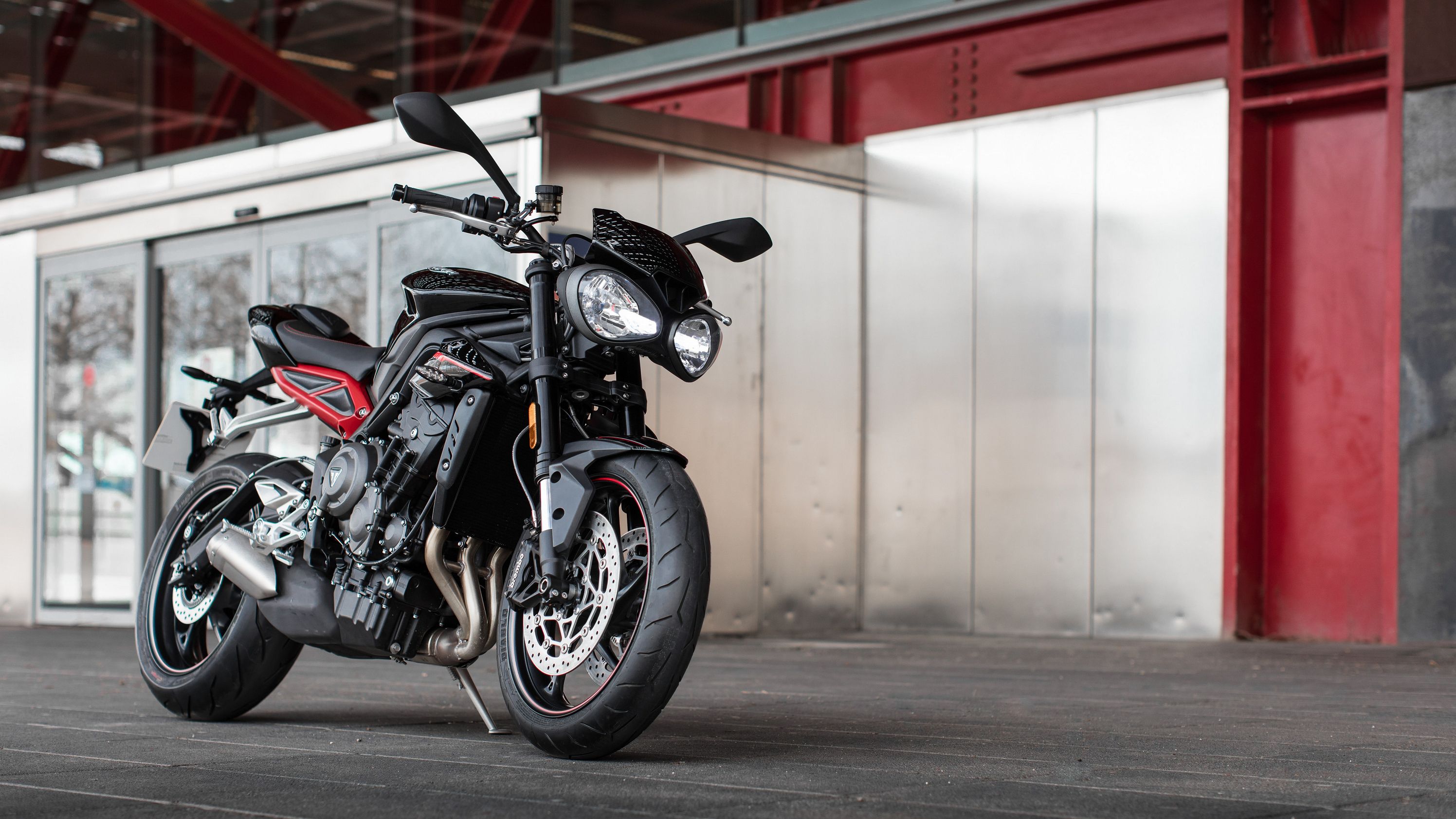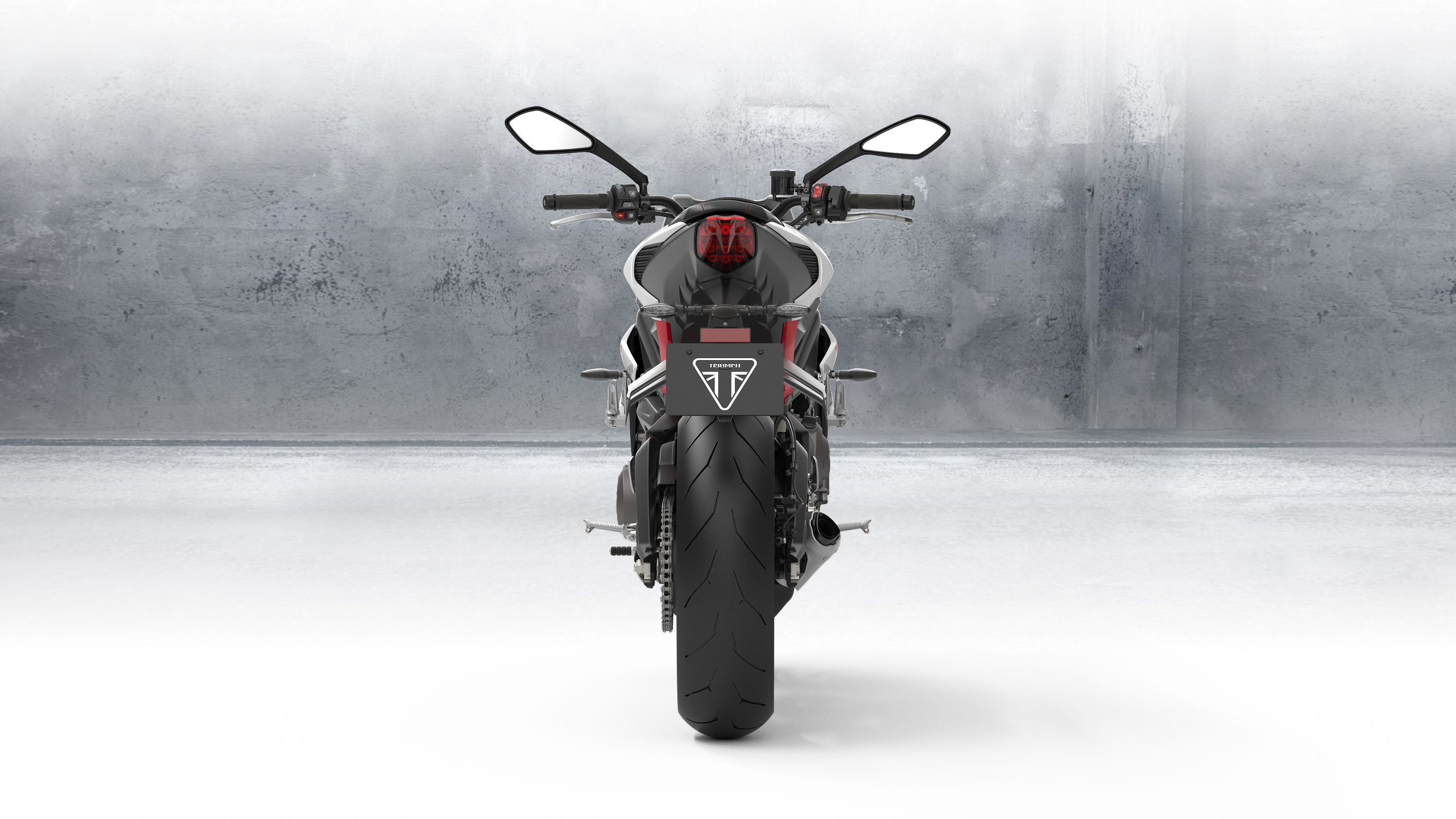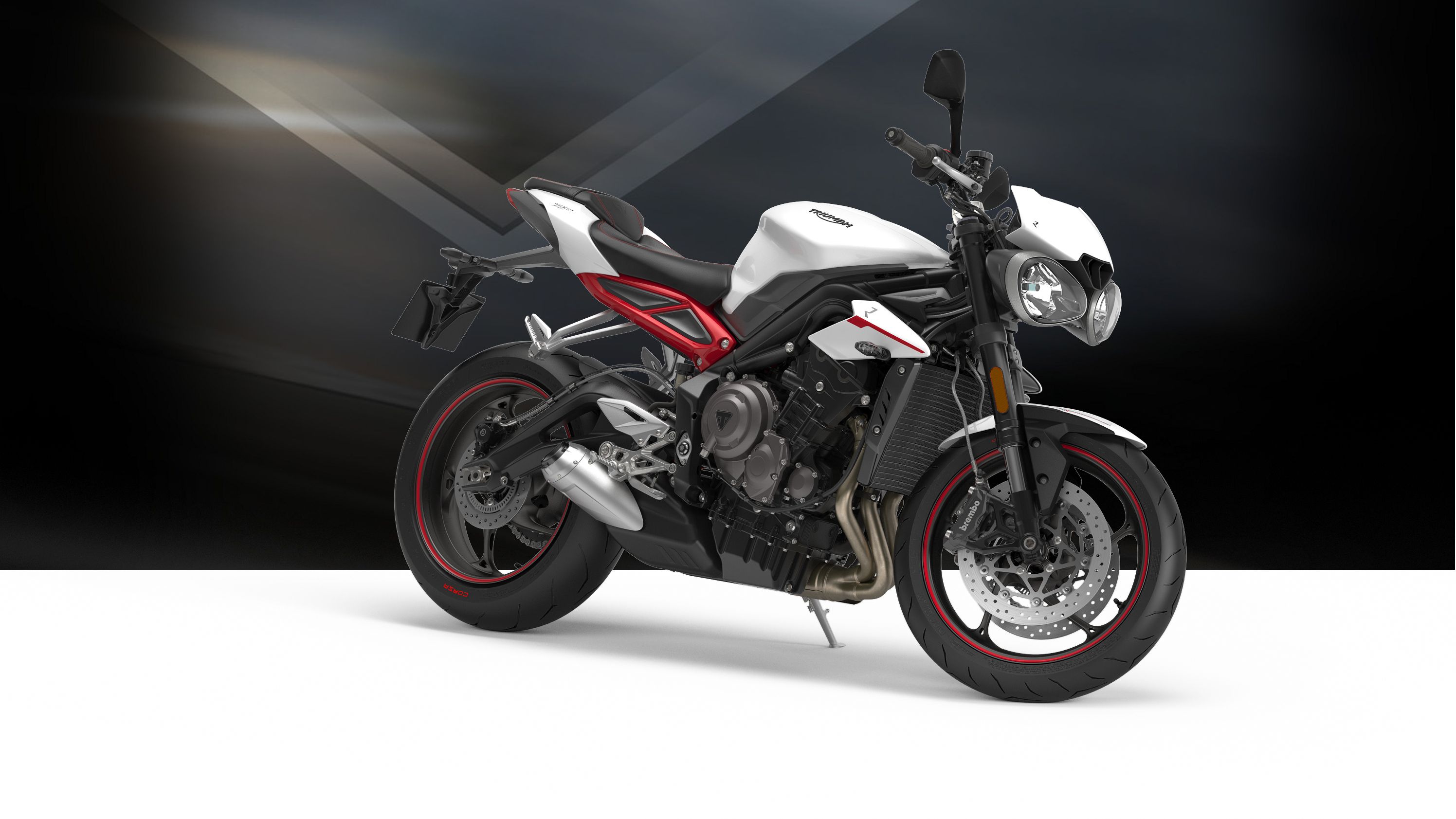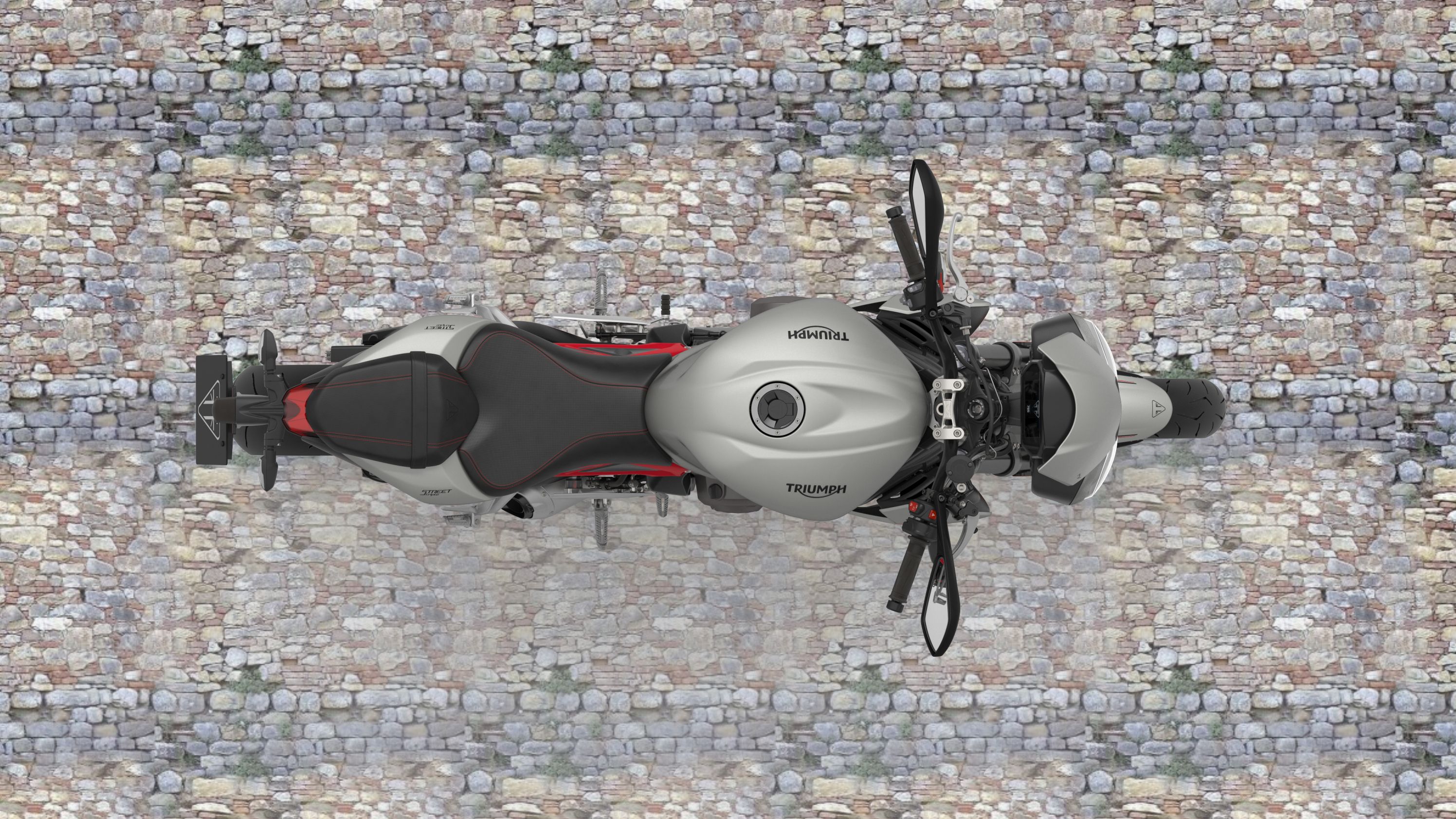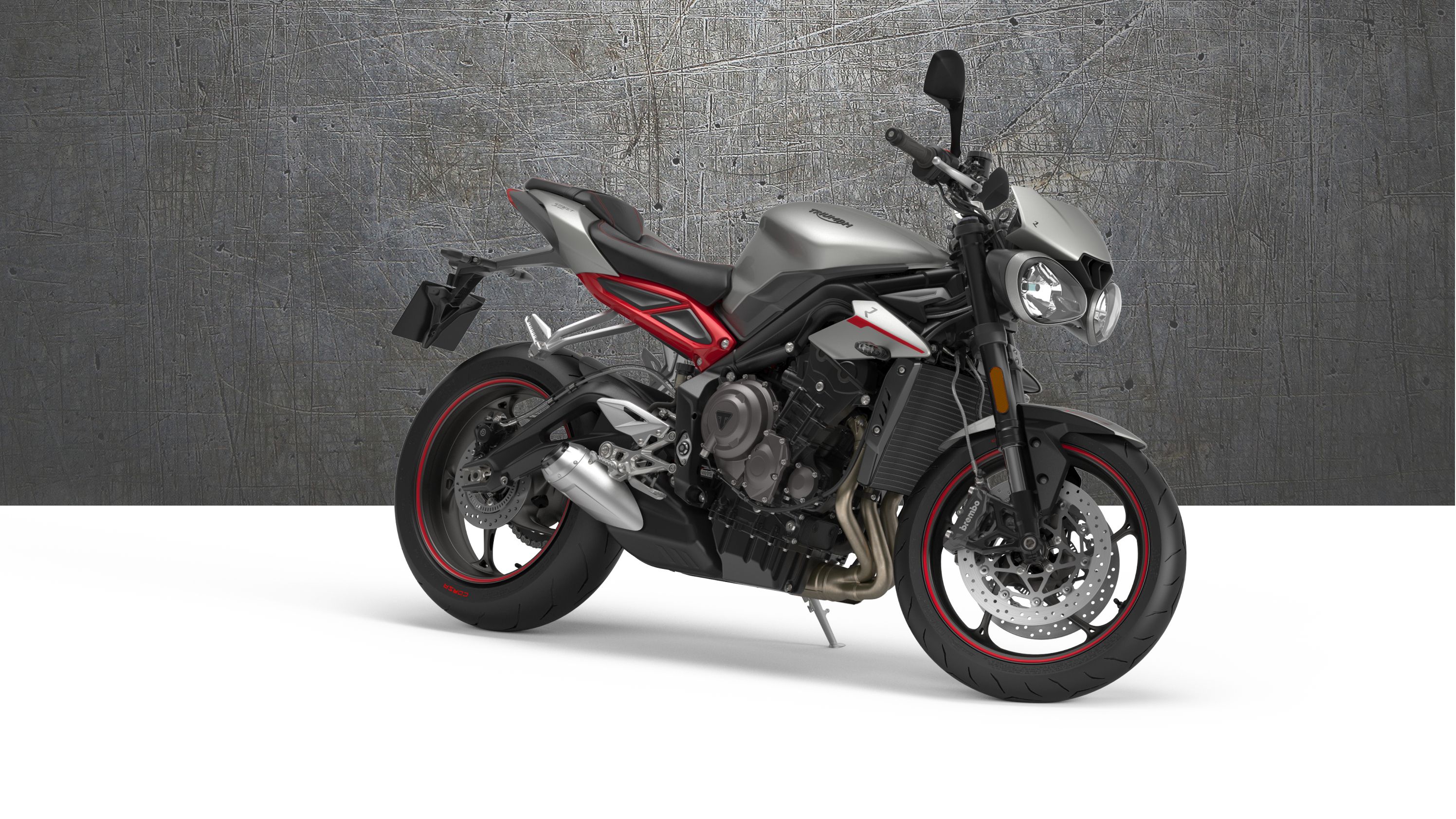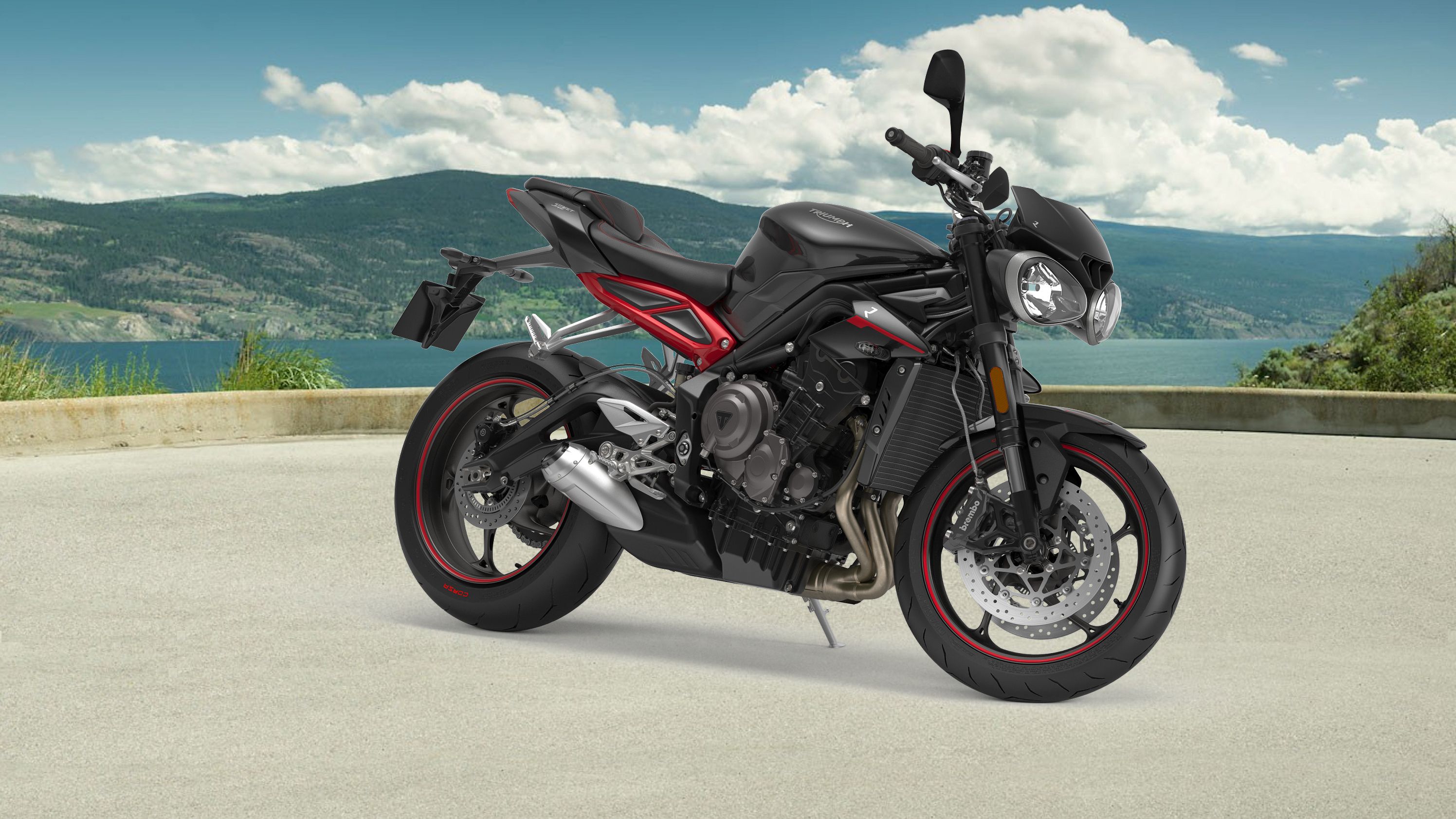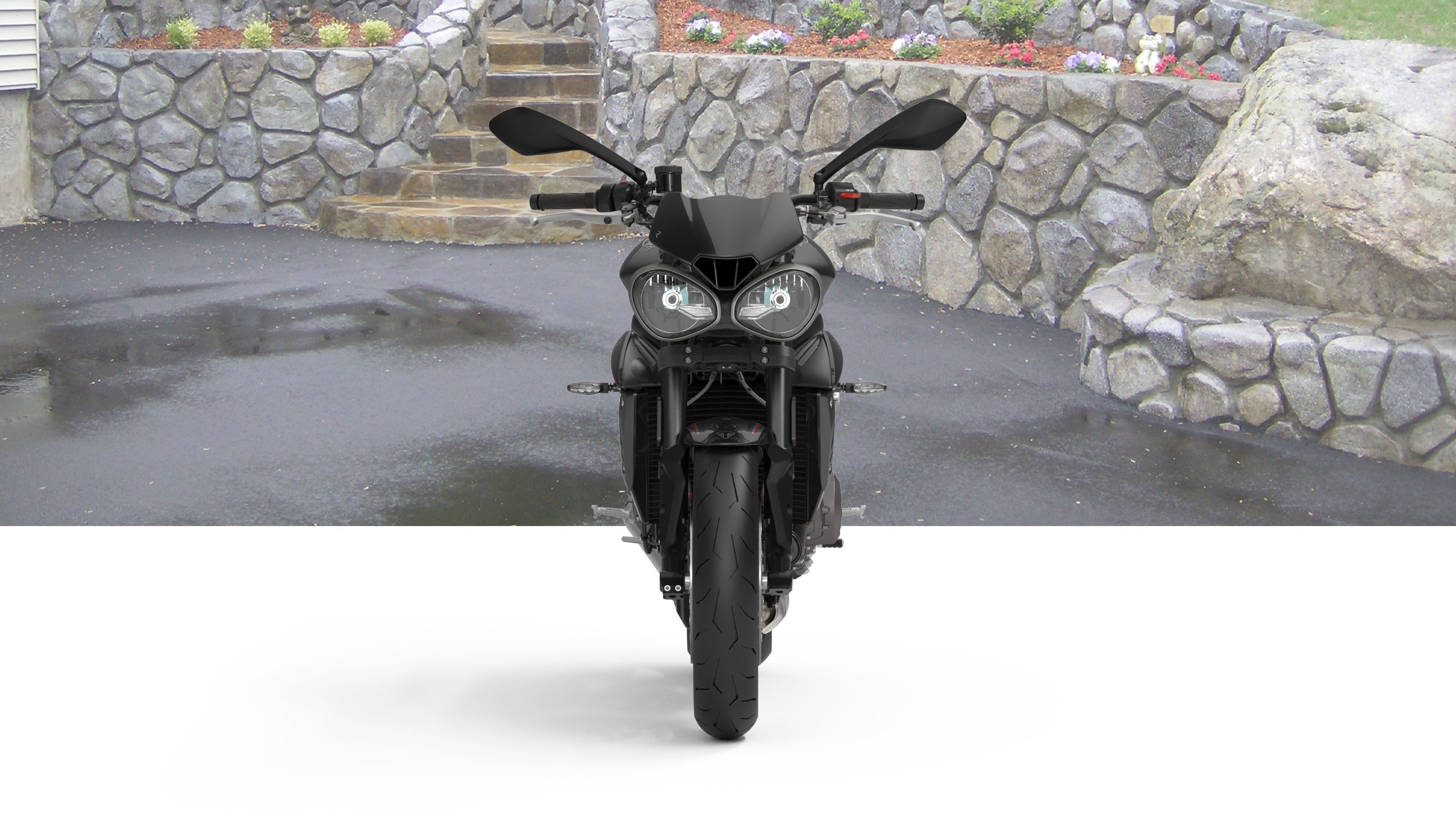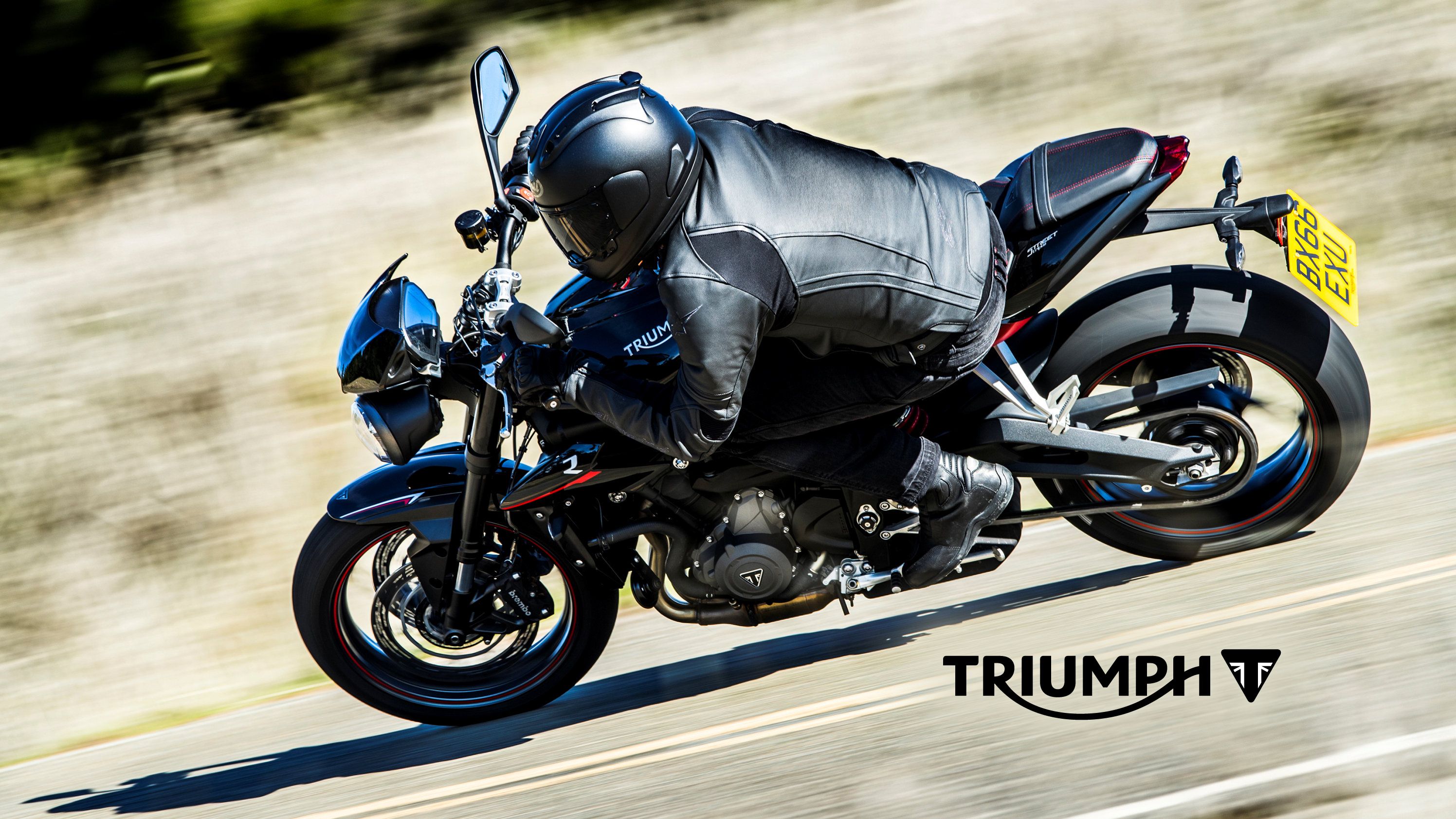Triumph raises the bar with a mid-level upgrade to its base Street Triple model with the Street Triple R and Street Triple R Low. These two siblings take the family to a more sport-tastic level with a number of upgrades to go with its aggressive good looks, starting with TFT instrumentation and extra electronic engine-control features that see riding modes added alongside the TC system, and an on-board ride computer that monitors and displays fuel burn rates, ambient temps and more. A souped-up engine powers the pair with 116 ponies in the paddock that are just waiting to be turned loose and let run. Upgraded suspension components improve handling with beefier brakes to haul it down, but that's just the broad strokes.
2018 Triumph Street Triple R
- Make: Array
- Model: 2018 Triumph Street Triple R
- Engine/Motor: inline-3
- [do not use] Vehicle Model: Array
Triumph Street Triple R Design
Lean and athletic, the “R” and “Low” carry themselves with the same aggressive nose-down/tail up posture that was such a hit with the previous models. You might expect the Low to have less of that, and it does, but not quite as much as you'd think. Naked sportbike, roadster or streetfighter; it doesn't matter what you call it, it's gonna' perform the same. The new design sports updated bodywork that emphasizes the aggressive nature of the family, and the R brothers come with some race-tastic red accents at the subframe, rims and cheek fairings.
A rather Spartan front fender rides between the beefy blackout stanchions with a matching dark-finish headlight can, tripletree and handlebar to visually tie it all together. The darkness spreads throughout to encompass the frame, engine, swingarm and rear mudguard on the Matt Aluminium (sic) Silver model and the Crystal White models, and of course, the Jet Black model goes a step further with glossy-black paint on the sheet metal and just a handful of bright spots to be found.
Behind the flyscreen resides a five-inch, full-color TFT screen that displays the usual metrics plus the performance info from the on-board computer, and it all comes with a choice between three different screen styles with contrast controls (manual and automatic) to maintain visibility in changing light conditions.
Moving aft, the 4.6-gallon fuel tank presents an appropriately sporty profile with a wide flange along the top to pull the legs into the recessed sides down low while providing a handy place to hang a knee when you decide to get a little jiggy with it in the corners. After the almost-level tank top and precipitous drop to the saddle, the narrow tank bottom feeds right into a skinny waist that also pulls the front of the rider's seat in to match. The seat itself is newly designed to separate pilot and pillion, but I gotta' say that the p-pad is vestigial at best and the design is meant to favor looks over comfort 'cause the skinny little strip of a pad is unlikely to cushion anything beyond the passenger's tailbone and naughty bits.
LED tech abounds on these rides and helps to keep the taillight compact where it sits, and indeed forms, the tip of the subframe with the rear turn signals and plateholder mounted on the mudguard. As with the “S” model, the hangy-downy rear fender is a bit off-putting, and I think a nice hugger would make these rides almost as sexy as some of the Italian rides; think Ducati and Aprilia.
Triumph Street Triple R Chassis
Weight savings were a front-burner issue for the engineers, and they started with the bones. An aluminum-beam, twin-spar frame forms the forward/upper section with a two-piece die-cast rear section to complete the structure. Steering rake measures out at 24.9 degrees with 3.9 inches of trail on a 56-inch wheelbase. This geometry lends itself to agile handling while the stiffness of the frame resists the tendency to flex under the cornering loads to provide stability and steady tracking in the curves. To further the corner-ability of the family, the swingarm pivot was tweaked a bit and the swingarm itself runs with a yoke-style, cast-aluminum construction and gull-wing shape that is meant to deliver the power to the pavement with more precise control and less deformation under a load.
Cast, five-spoke 17-inch rims mount Pirelli's Diablo Rosso Corsa hoops with a 120/70 to lead the way and a 180/55 to bring up the rear. That's sticky rubber and treads farther up the sidewall than I will ever need, I assure you. Dual 310 mm discs and four-piston, Brembo M4.32 monobloc calipers slow the front with a 220 mm disc and single-bore Brembo clamp to slow the rear. The ABS feature can be adjusted, or even turned off entirely through the rider-mode interface, and it comes with a “Track” setting so as not to interfere with your lap time, 'cause ain't nobody got time for that, right?
Inverted Showa separate-function big-piston front forks run with 41 mm diameter tubes in the strong blackout stanchions, and both models enjoy adjustable compression, rebound and preload. Out back, the R runs a Showa piggyback shock with the same full-spectrum adjustments as the front while the Low runs the same but is limited to preload and compression adjustments.
That's not the only difference between the two; suspension travels differ to allow for the seat-height offset. The R runs a 32-inch seat height with 5.27 inches of wheel travel out back and 4.52 inches of travel up front, but the Low pulls the saddle down to 31.2 inches off the ground with 3.74 inches up front and 3.85 inches out back. That's still plenty of travel, and that's the price you pay for a slightly lower butt bucket.
|
Frame: |
Front - Aluminum beam twin spar. Rear - 2 piece high pressure die cast |
|
Swingarm: |
Twin-sided, cast aluminum alloy |
|
Front Wheels: |
Cast aluminum alloy 5-spoke 17 x 3.5 in |
|
Rear Wheels: |
Cast aluminum alloy 5-spoke 17 x 5.5 in |
|
Front Tires: |
120/70ZR17 |
|
Rear Tires: |
180/55ZR17 |
|
Front Suspension: |
Showa 41mm upside down separate function big piston forks (SF-BPF), 115mm front wheel travel. Adjustable compression damping, rebound damping and adjustable preload |
|
Rear Suspension: |
Showa piggyback reservoir monoshock, 134mm rear wheel travel. Adjustable spring preload (lock-rings), compression damping and rebound damping. |
|
Brakes Front: |
Twin 310 mm floating discs, Brembo M4.32 4-piston radial monobloc calipers, switchable ABS |
|
Brakes Rear: |
Single 220 mm fixed disc, Brembo single piston sliding caliper, switchable ABS |
Triumph Street Triple R Drivetrain
Daytona race-engine DNA plays a part in the design of the Triple's 765 cc triple, but that's just the foundation upon which the finished product is built. Trumpet's engineers changed over 80 individual components to evolve the mill into its next level of development and broaden the powerband with an all-new model-specific crankshaft, pistons and cylinder treatment to name just a few. This inline triple runs a dramatically oversquare layout with enlarged, 78 mm Nikasil-coated bores and a 53.4 mm stroke.
Compression is sizzling hot at 12.65-to-1 with an engine water jacket and radiator to deal with all that thermal energy, but I'll tell ya now that you can go ahead and disabuse yourself of the notion that you'll be feeding it anything less than the highest-grade road champagne commonly available at the pump. It is what it is, and that's the price you pay (everytime you fill up) if you want that performance.
The R's mill grinds out a total of 116.4 horsepower at a lofty 12,000 rpm with 57 pound-feet of torque that maxes out at 9,400 rpm but starts to “come on” much lower in the rev-range than did the previous generation. That's a lot of power to control, for sure, but Trumpet has your back with some gadgetry to help you out. As usual, the magic starts out with a ride-by-wire throttle that controls the induction with electronic fuel injection to tend to the mixture. The Riding Modes feature gives the “R” a total of four power-delivery profiles for differing conditions; Sport, Rain, Road and a rider-programmable profile so you can dial right in to your personal preferences. A Traction Control system delivers a total of five settings; Rain, Road, Track, Sport and Off for another layer of control and customization. A five-way joystick gives the rider an intuitive and easy way to navigate the menus and make adjustments, sitting still or on the fly.
If you're into racing, or more likely just like to pretend you'd not get lapped by a real racer, you may lament the lack of a quickshifter. The “R” comes set up to easily accept an accessory Quickshifter like the one that comes stock on the race-tastic RS model.
|
Engine: |
Liquid-cooled, 12 valve, DOHC, in-line 3-cylinder |
|
Displacement: |
765 cc |
|
Bore x Stroke: |
3.07 in (77.99 mm) x 2.10 in (53.38 mm) |
|
Compression: |
12.65:1 |
|
Max Power EC: |
116 hp (86.8 kW) @ 12,000 rpm |
|
Max Torque EC: |
57 lb-ft (77 Nm) @ 9,400 rpm |
|
System: |
Multipoint sequential electronic fuel injection with SAI. Electronic throttle control |
|
Exhaust: |
Stainless steel 3 into 1 exhaust system low single sided stainless steel silencer |
|
Final drive: |
O ring chain |
|
Clutch: |
Wet, multi-plate, slip-assisted |
|
Gearbox: |
6-speed |
Triumph Street Triple R Price
Regardless of which of these you choose, you can expect to pay the same price. The Jet Black model fetches $11,250, while the Matt Aluminium Silver roll for $11,500.
|
Color: |
Jet Black, Matt Aluminium Silver |
|
Price: |
Jet Black: $11,250, Color: $11,500 |
Triumph Street Triple R Competitor
As tempting as it was to go to Japan for a worthy competitor, the good looks of the bike steered me instead to Europe's Boot where I found the Monster 821 from Ducati. These two streetfighters display much the same naked looks, but as expected, the Italian's passionate nature quickly becomes evident in the voluptuous curves and sensuous panache of the Monster. Tucked-in and cut-back, the front fender, lighting and hang-on gear keeps it nice and tight with a minimal subframe/tail section and recessed taillight; too bad the read mudguard clutters up the rear end just a skosh, but there's always the aftermarket for a nice hugger to clean that right up. In short; the Street Triple ain't a bad looking bike, but the Monster is like the Triple's hot sister.
Surprisingly, Duc falls behind in the suspension with non-adjustable usd forks up front though the rear end comes with some adjustability. The Trellis frame uses the engine as a stressed member to reduce weight, and it sports equally agile steering geometry with 24.3 degrees of rake and 3.67 inches of trail that will be as eager in the corners as your courage will allow.
Brakes are likewise similar with Brembo calipers and dual 320 mm front discs with Bosch ABS on overwatch. The Monster's Testastretta powerplant packs in more cubage at 821 cc, but due to the L-twin configuration, the power figures are a mixed bag. Torque clocks in at 63 pounds o' grunt for the Duc, a bit more than the Triple's 57 pounds, but horsepower falls off at 109 ponies against Triumph's 116. Ducati manages to pack in even more electronic wizardry with its proprietary traction control, riding modes and power modes on top of the ABS for a slight edge in the fandanglery and pricing is a toss-up with the Monster 821 coming off as slightly prouder with its $11,995 sticker, but that isn't enough to be a dealbreaker, not by a long shot.
He Said
“I hate to say it, but personally, I like the Monster just a tad more. There's nothing wrong with the Street Triple R/Low, but it's hard to escape those Italian good looks and proven engine/tech. That said, much like the Street Triple S, the R/Low brethren are not entry-level machine and are definitely worthy of respect.”
She Said
My wife and fellow motorcycle writer, Allyn Hinton, says, “There was a lot of hype leading up to the release of the Street Triple R, and it was interesting to see if the bike was up to the hype. It's almost a sporty-standard riding position with feet tucked but body upright and the handlebars are at a comfortable width. With the backend from the Daytona 675, the seat is kinda hard like I would expect on a sportbike. I'm not going to gig it for that because it doesn't seem like a bike that I'd be on for long stretches, so there's that. I gotta say, though, that while I'm not a fan of digital instruments, the TFT screen is very readable. It very clear and it was quite easy to take in the numbers at a glance, which I'm not so good with on other digital displays. Younger folks with better eyesight don't have that problem, so there's that, as well. The ride and the power delivery is very smooth and it just keeps giving.”
Triumph Street Triple R Specifications
|
Engine & Drivetrain: |
|
|
Engine: |
Liquid-cooled, 12 valve, DOHC, in-line 3-cylinder |
|
Displacement: |
765 cc |
|
Bore x Stroke: |
3.07 in (77.99 mm) x 2.10 in (53.38 mm) |
|
Compression: |
12.65:1 |
|
Max Power EC: |
116 hp (86.8 kW) @ 12,000 rpm |
|
Max Torque EC: |
57 lb ft (77 Nm) @ 9,400 rpm |
|
System: |
Multipoint sequential electronic fuel injection with SAI. Electronic throttle control |
|
Exhaust: |
Stainless steel 3 into 1 exhaust system low single sided stainless steel silencer |
|
Final drive: |
O ring chain |
|
Clutch: |
Wet, multi-plate, slip-assisted |
|
Gearbox: |
6-speed |
|
Chassis: |
|
|
Frame: |
Front - Aluminum beam twin spar. Rear - 2 piece high pressure die cast |
|
Swingarm: |
Twin-sided, cast aluminum alloy |
|
Front Wheels: |
Cast aluminum alloy 5-spoke 17 x 3.5in |
|
Rear Wheels: |
Cast aluminum alloy 5-spoke 17 x 5.5in |
|
Front Tires: |
120/70ZR17 |
|
Rear Tires: |
180/55ZR17 |
|
Front Suspension: |
Showa 41mm upside down separate function big piston forks (SF-BPF), 115mm front wheel travel. Adjustable compression damping, rebound damping and adjustable preload |
|
Rear Suspension: |
Showa piggyback reservoir monoshock, 134mm rear wheel travel. Adjustable spring preload (lock-rings), compression damping and rebound damping. |
|
Brakes Front: |
Twin 310mm floating discs, Brembo M4.32 4-piston radial monobloc calipers, switchable ABS |
|
Brakes Rear: |
Single 220mm fixed disc, Brembo single piston sliding caliper, switchable ABS |
|
Dimensions & Capacities: |
|
|
Width Handlebars: |
29 in (735 mm) |
|
Height Without Mirror: |
43 in (1085 mm) |
|
Seat Height: |
32 in (825 mm) (R Low: 31.3 in (795 mm) |
|
Wheelbase: |
56 in (1410 mm) |
|
Rake: |
23.9º (R Low: 24.9º) |
|
Trail: |
3.9 in (100 mm) |
|
Dry Weight: |
366 lbs (166 kg) |
|
Tank Capacity: |
4.6 gal (17.4 l) |
|
Fuel Consumption: |
49 mpg (4.8 l/100 km) (GTR2) |
|
Details: |
|
|
Instrument Display and Functions: |
Full-color, 5" TFT instrument pack with 3x styles and high/low contrast options |
|
Color: |
Jet Black, Matt Aluminium Silver |
|
Price: |
Jet Black: $11,250, Color: $11,500 |
Further Reading
Ducati Monster 821
See our review of the Ducati Monster 821.
Triumph Street Triple S
See our review of the Triumph Street Triple S.
Triumph
Read more Triumph news.

